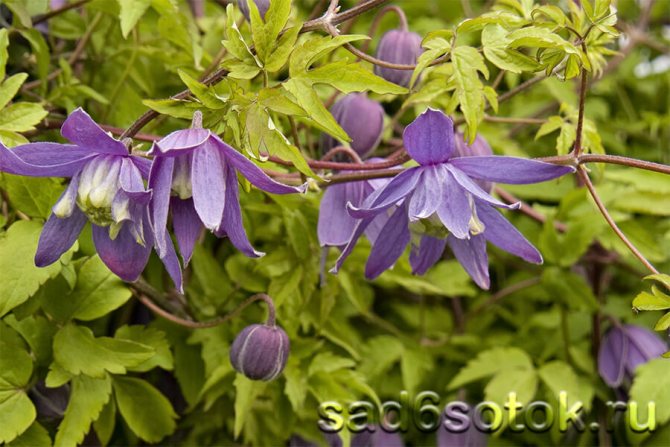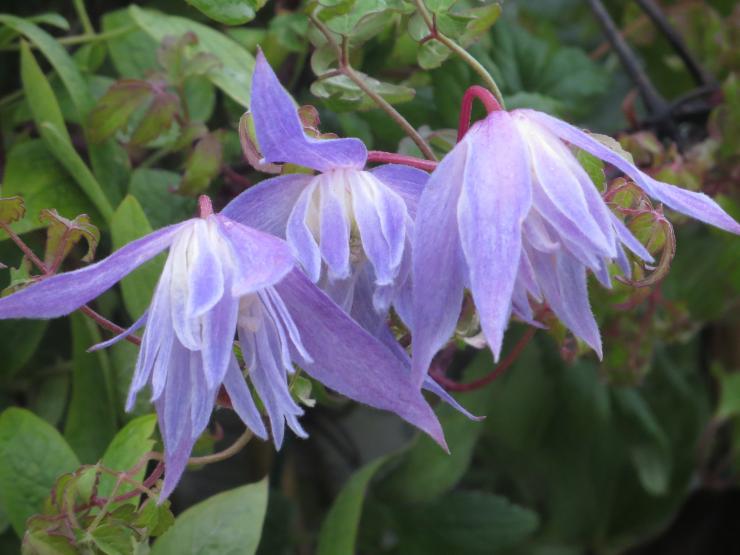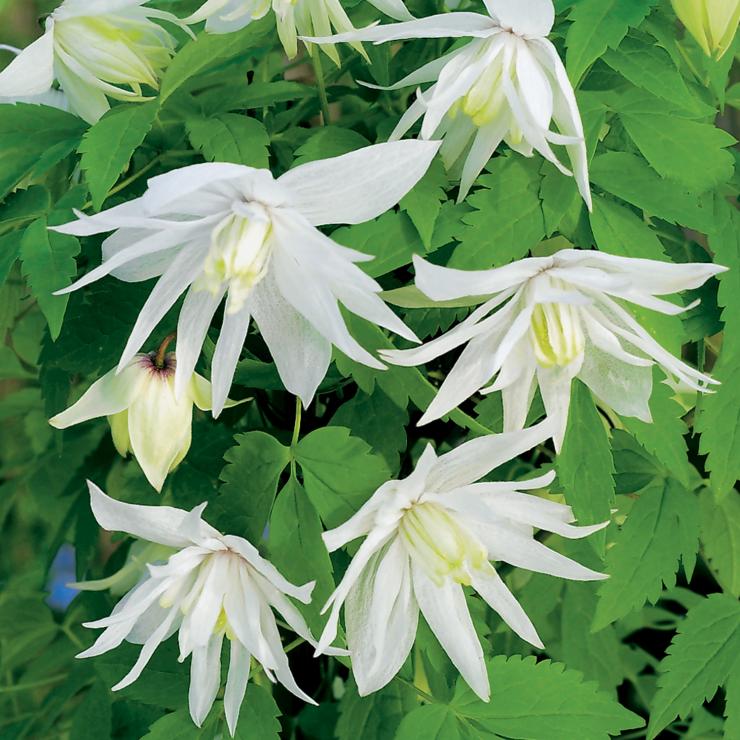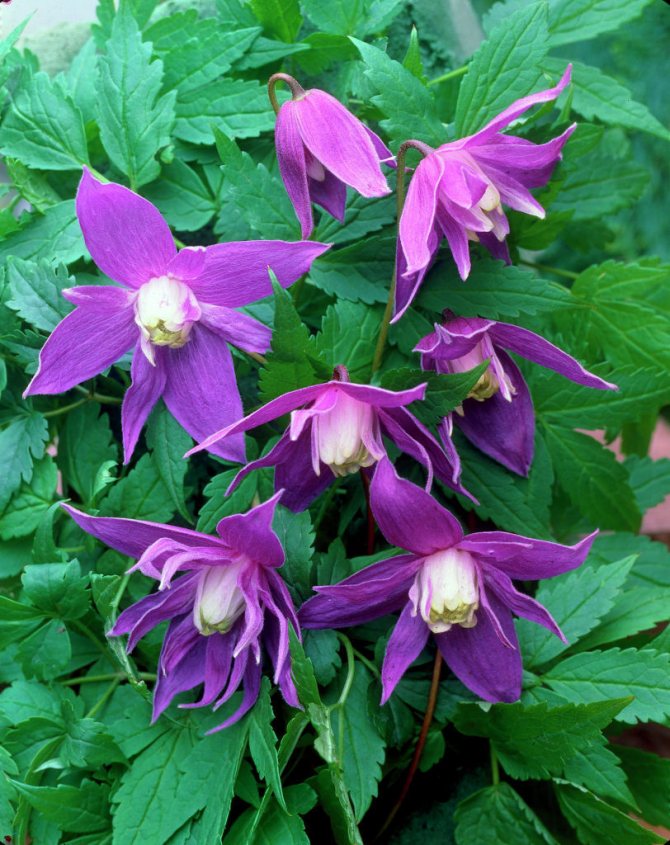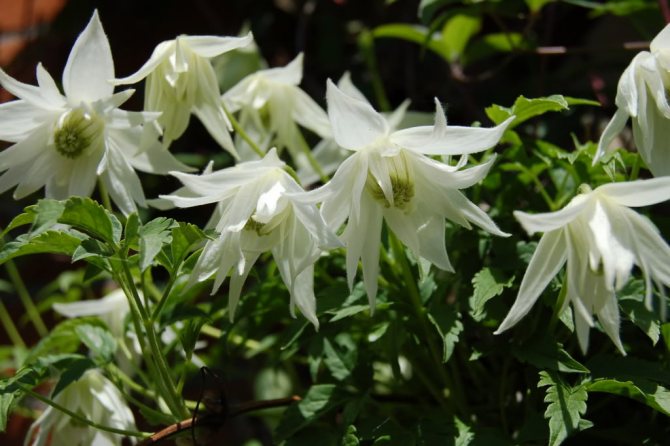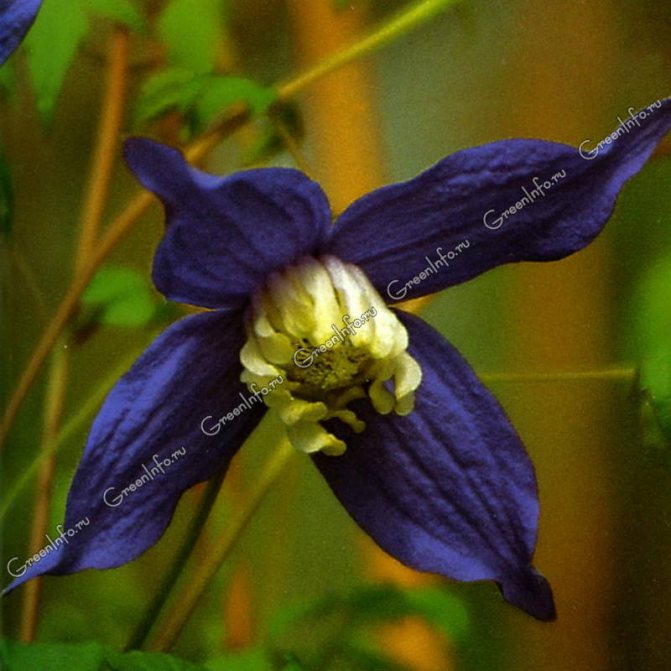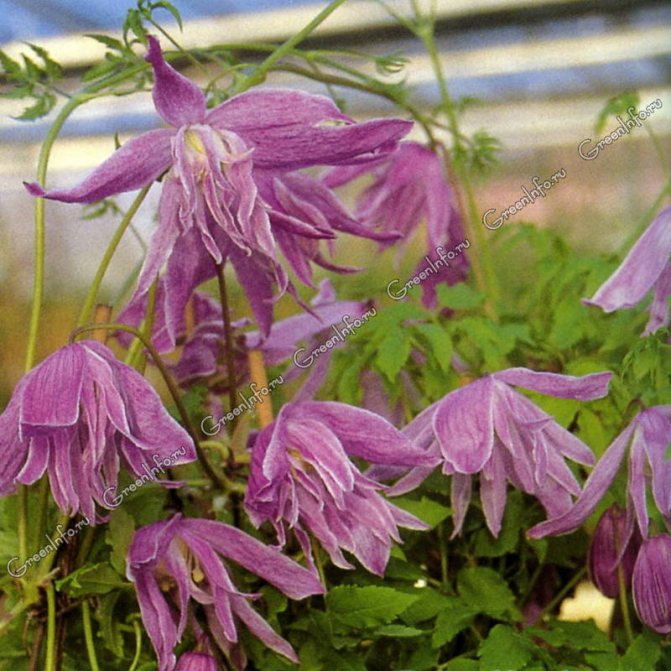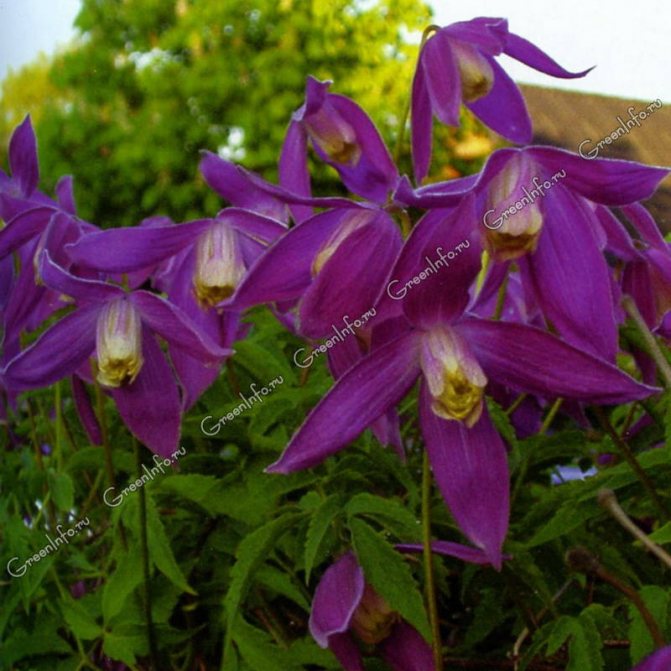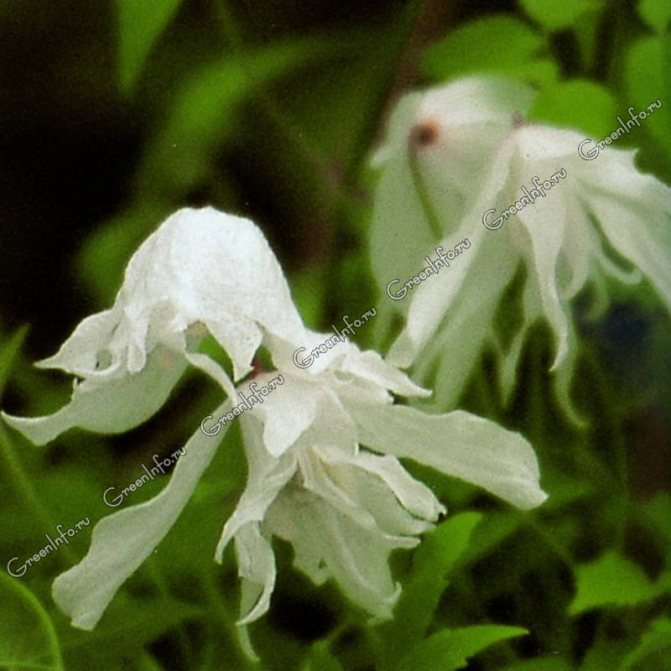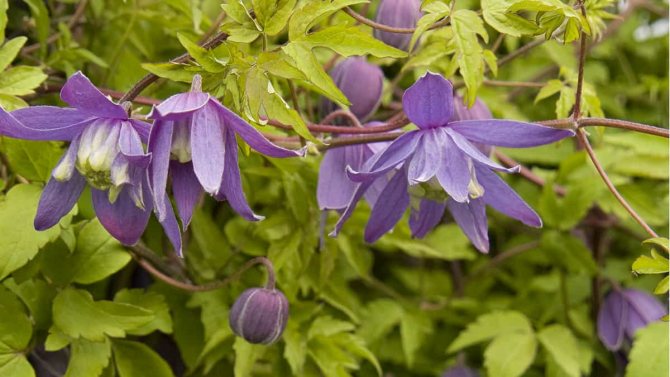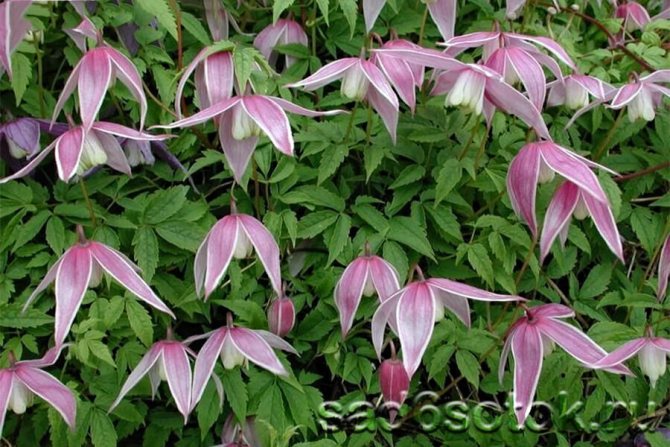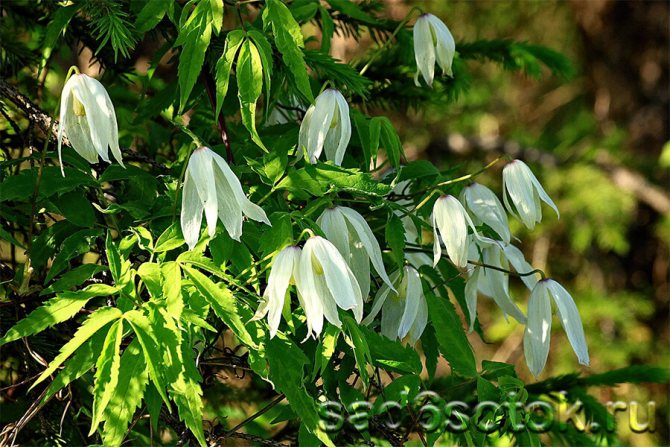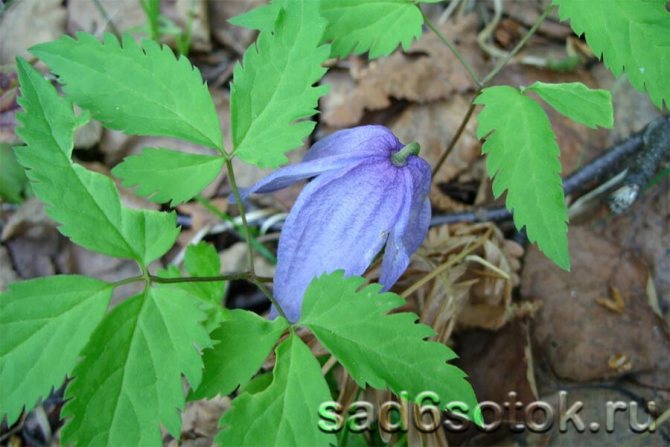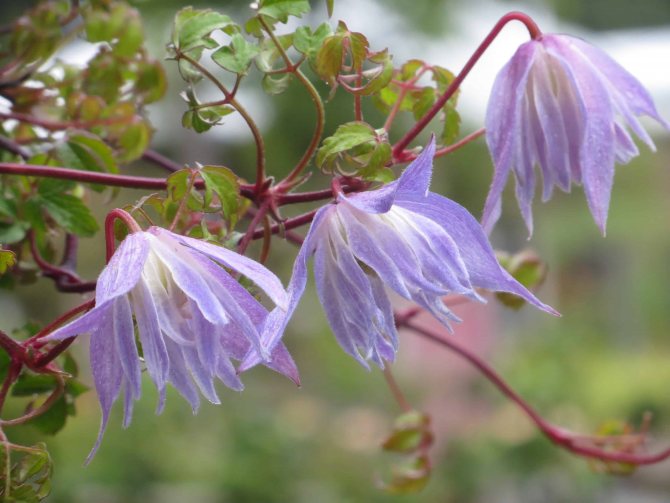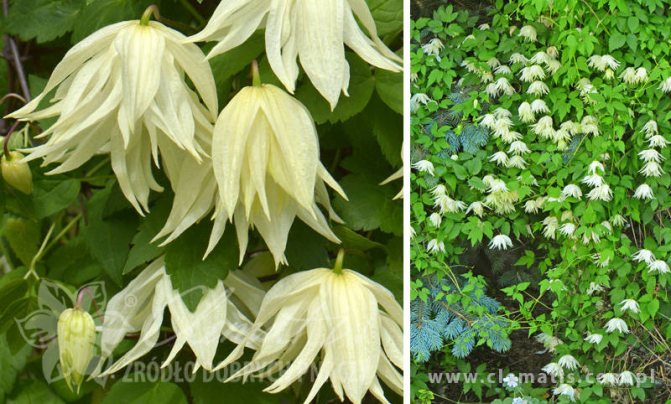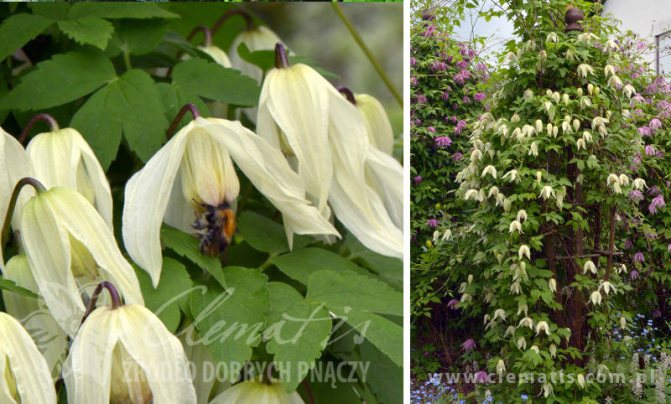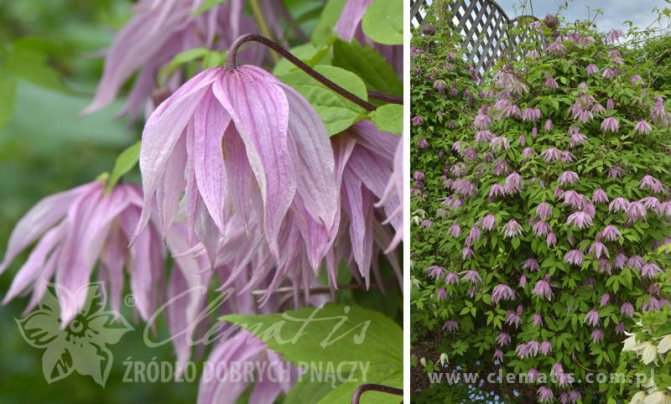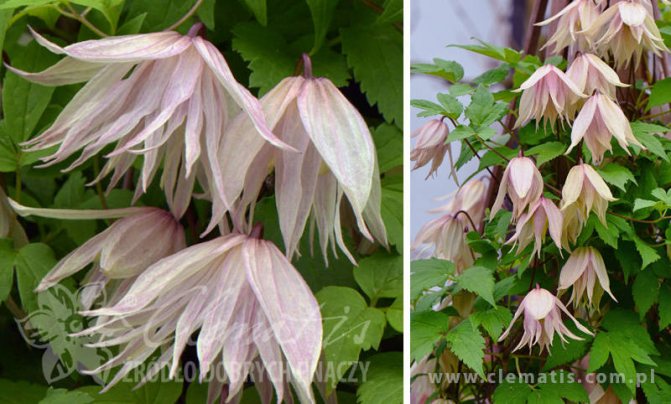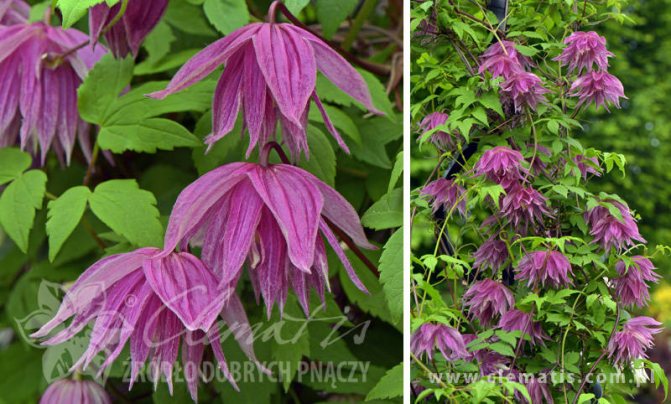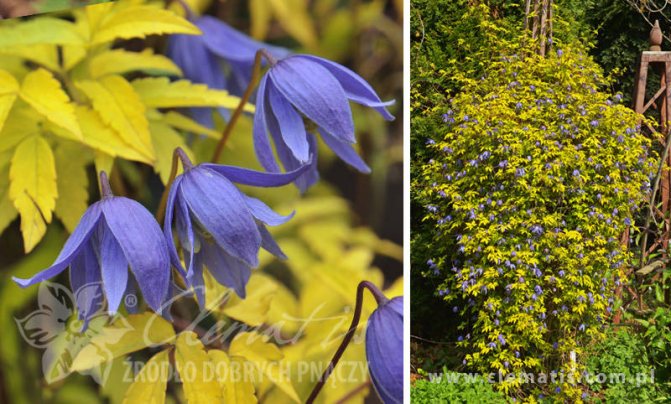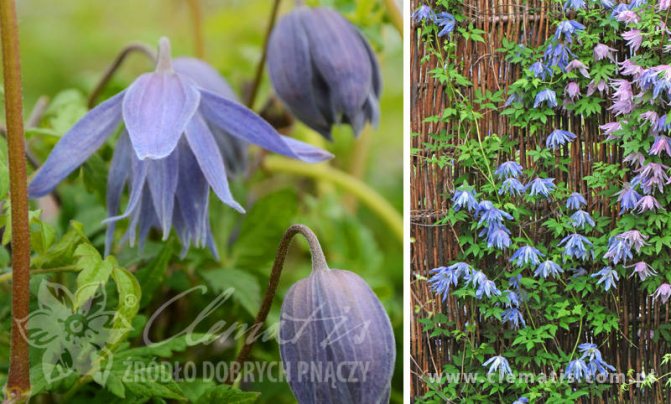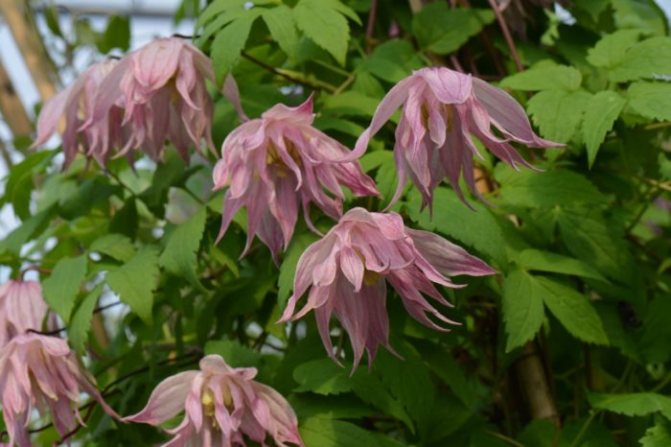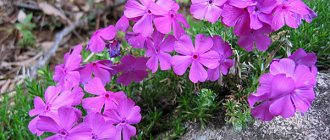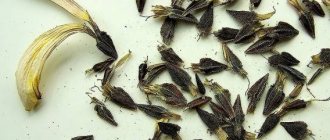Knyazhiki is a perennial shrub vine. Planting the princes in open ground is not very difficult. Many people think that the princes belong to the clematis genus. We can say that this is so, but still they have some differences. The prince has small flowers with delicate petals, from below they are framed by a cup with leaves. Clematis does not have petals, it has a cup of leaves, which some gardeners mistake for the flower itself.
Alpine prince with purple flowers
The prince looks more graceful than clematis. It grows to a height of about 3 meters. The flexible stem, covered with small carved leaves, has many shoots. Princes bloom in early summer. An elongated bud is formed on a peduncle 10-12 centimeters in size. As it blooms, it becomes like a bell with inflorescences of white, purple flowers. Princes differ from clematis in non-accrete, separately located petals. At the end of flowering, in place of the buds, round, fluffy fruits of a bizarre appearance are formed. Clematis is attached to the support in the same way as the princes - with young leaves. For these purposes, a rope or wire mesh is best suited.

Prince of Okhotsk
Siberian prince - description, varieties, cultivation and reproduction
Hello dear readers! Today we will get acquainted with a close relative of clematis, a peculiarly charming, unpretentious in care and still a rare flower in our gardens - the prince of Siberia.
Siberian prince cannot boast of lush and bright flowers, like varietal clematis, but it has a special charm. Snow-white fragrant flowers with four drooping, as if chiseled, sepals look very elegant, even touching, among the carved leaves. The prince also has real petals, unlike clematis - they are inside the calyx and surround the long stamens.
The plant is decorative not only at the time of flowering, but also in early spring (leaves bloom earlier than many other vines), and in autumn due to pubescent fruits. An unpretentious perennial flowering liana is perfect for group plantings (4-6 specimens), placement near walls, fences, terraces, and arches.
Application of the prince
Princes can beautifully frame a fence, balcony or staircase. They can decorate any wall. A gazebo or tree decorated with flowers will emphasize the originality of any garden.
This climbing crop takes up very little space in the garden and can therefore be planted instead of trees or shrubs. Its bushy shoots and leaves and gorgeous colorful flowers can protect from bright light and dust while shading the area well.
This flower is best planted next to an arch or veranda, taking into account that it is a climbing culture. As it grows, it will wrap around nearby objects. In one place, a culture can grow up to 10 years. Poorly tolerates transplantation due to the fragility of the root system.
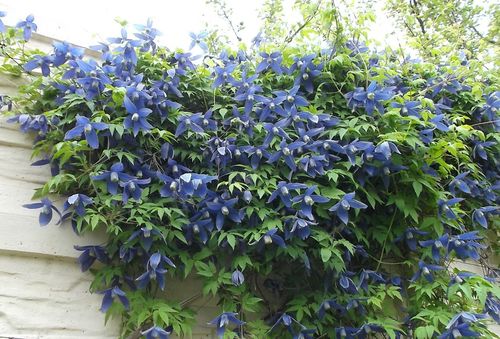

The medicinal properties of the prince are widely known. Various tinctures are made from this plant, which serve as a general tonic for the body.
These noble flowers can decorate both the garden and the walls of any home, if you provide them with the necessary space and all the conditions for growth. Planting and caring for the plant will give a lot of pleasure to true lovers of these flowers. The prince and clematis complement each other well.Thanks to the princes, the flowering of the northern garden is extended for half a month. These flowers are very decorative not only during flowering, but also during budding.
Features of agricultural technology
There are some nuances in the agrotechnics of the Siberian prince. For example, princes do not like stagnant water at the roots, they grow poorly in places open to strong winds. They are undemanding to soils. They grow well in partial shade - here they bloom longer than in the sun, and the flowers are larger, because in nature, vines are used to being under the canopy of trees.
Carefully select a place for the Siberian prince in the garden in advance, since they are difficult to tolerate a transplant. In the first two years for the winter, it is better to cover seedlings with spruce branches or covering material. An adult plant is winter-hardy and does not require shelter, it can not even be removed from the support. However, it still depends on your desire and how severe the winters are in your area, as well as on the microclimate of the site.
Caring for the prince
Caring for the culture is quite simple, so this type is also suitable for novice summer residents. The plant is unpretentious and does not require any special conditions. During the summer cottage, it is necessary to carry out at least three dressings with mineral and organic fertilizers.
This is done alternately - from the beginning of growth to the formation of buds. In the soil prepared in advance, the prince can not be fed in the first year of life.
Pruning is carried out as the shoots grow back and dry out. This procedure must be carried out in the spring to form a bush, and during the summer you only need to remove damaged and dry stems.
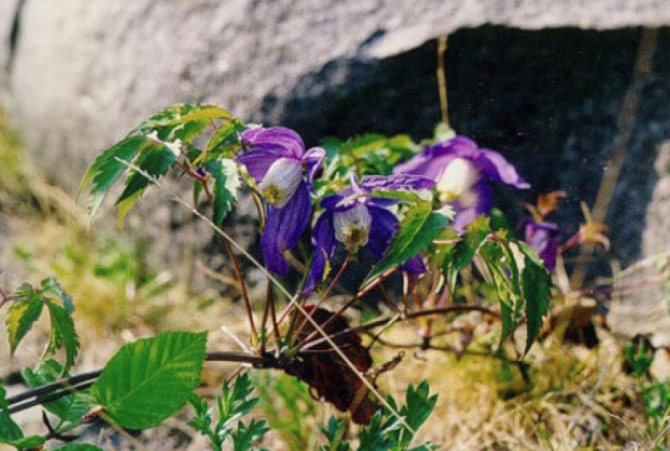

In the garden, the plant can grow at will, but if it is a decoration of the front door, it needs to be shaped regularly. The lower part of the stems can be shaded by planting a hosta plant at a distance of 50 cm from the vine.
Reproduction of the prince
You can propagate the Siberian prince by seeds (seedlings will bloom for 3-4 years), layering, lignified and green cuttings. Seeds are best sown in autumn after ripening in a separate bed. Seedlings will appear in the spring, and it is better to transplant the plants to a permanent place in the fall of the same year, or next spring. The older the plant, the more difficult it is to take root.
For reproduction of the Siberian prince by layering, bend the shoot to the ground and pin, sprinkle with soil. It will be possible to separate and transplant a new plant next year.
A stalk of a Siberian prince will take root well if you cut it off in late June-early July, and root it in a greenhouse. Pour expanded clay with a layer of 10-15 cm, then washed river sand with a layer of 7-8 cm. For grafting, cut off the middle part of the shoot with one or two nodes. Step back 4-7 cm under the knot and make an oblique cut, process it with Kornevin. Place the cuttings at a distance of 7-12 cm, deepening the buds by 2-4 cm. Rooting of the princes lasts 25-30 days.
Planting seeds
Seed propagation is quite often used when you need to grow princes. Planting and caring for seedlings is not particularly difficult even for novice gardeners. In pots filled with earth and sand in a ratio of 2: 1, seeds are sown and covered with a thin layer of sand, slightly dripping. Then water and cover the soil with glass.
When at least 3 pairs of leaves appear on the plant, a dive can be made on prepared ridges, consisting of sod land, humus, leafy earth, sand and peat. Plants are planted in rows, the distance between which is at least 25 cm. Seedlings must be shaded and watered as the soil dries. When new leaves appear, the soil in the aisles is thoroughly loosened and mulched.
Only next autumn or spring are young plants transplanted to a permanent place, most suitable for such a flower as a prince. Photos of areas where these plants fit harmoniously into the design and are a worthy garden decoration can help in this.
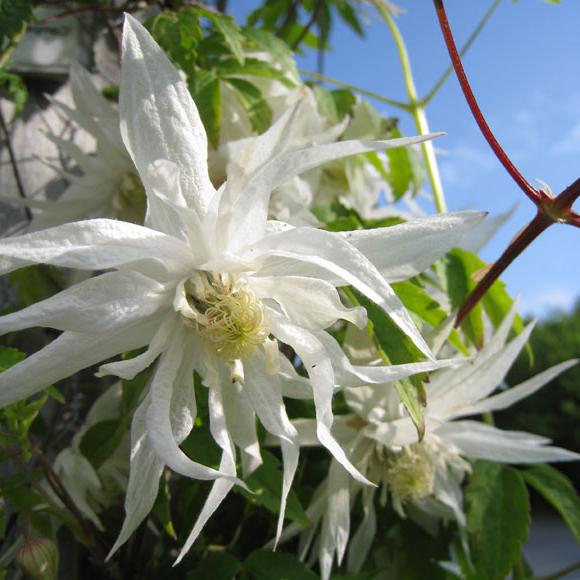

Types and varieties of prince
Other types of princes are also grown in the gardens - Alpine prince, large-scale, Okhotsk and, of course, various varieties and hybrids... They have white flowers (Albina Plena, White Swan, White Columbine), blue (Lagoon, Alpina, Blue Princess, Blue Dancer, Pamela Jackman, Blue Bird, Cecile), soft pink (Pink Flamingo, Pink Princess, Willy, Ballet Skirt, Markham Pink), bright pink (Ruby, Constance), as well as pale lilac (Maidwell Holl), purple-violet (Tage Lundell). Stolwijk Gold looks especially beautiful. Throughout the growing season, from spring to snow, its foliage is bright yellow, and even in cloudy weather, the plant looks as if it is illuminated by sunlight.
I hope you have read this article with interest, and it turned out to be useful. Perhaps the materials presented in the article, you think are controversial, and you disagree with something, then share your opinion in the comments. If the topic touched upon is interesting to you, and you share the author's point of view, share these materials with your friends on social networks using the buttons under the article. And also the blog provides a free subscription form so that you can be the first to receive new articles about ornamental trees and shrubs to your email address:
Views
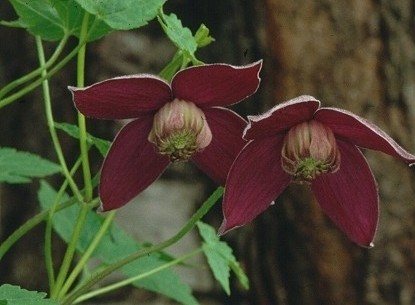

Of those princes who grow in the forests of our country, they grow in gardens:
- large-petaled;
- Siberian;
- prince of Okhotsk.
In addition to them, there is an alpine prince.
One of the first to bloom is the Alpine representative, followed by the Okhotsk and Siberian. Competent planting of different types of prince and clematis will help create constantly blooming compositions.
Popular species and varieties
The prince is the closest relative of clematis, but less demanding in care. All types of prince are shrub vines with woody shoots 2–4 m high. Leaves are pinnate, with jagged edges and petioles with which they cling to the support.
Flowers are solitary, drooping up to 10 cm in diameter, growing from the axils of the leaves. Flowers consist of 4-8 sepals, ovoid or lanceolate. There are numerous light-colored stamens inside the flower. The color of the flowers can be purple, pink, white, pale yellow.
The prince blooms en masse in May-June. Individual flowers can bloom throughout the summer. In August-September, the fruits ripen, collected in a fluffy head.
Of the 8 types of prince, 4 are grown on the territory of our country.
Grand Duchess
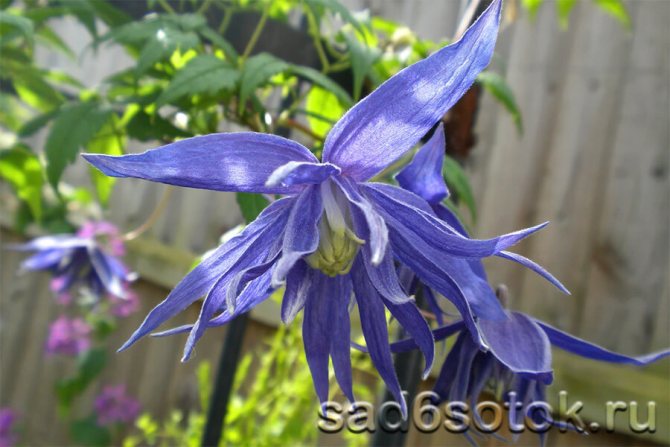

Originally from Siberia and the Far East. It differs from other species in the shape of the flower. They look more voluminous due to the superposition of large outer sepals on the narrow inner ones.
Popular varieties: dark blue "Maidville Hall" 2-3 m high, "Rosie O'Grandy" with pink double flowers, winter-hardy variety Estrella, snow-white "Memm".
Alpine prince
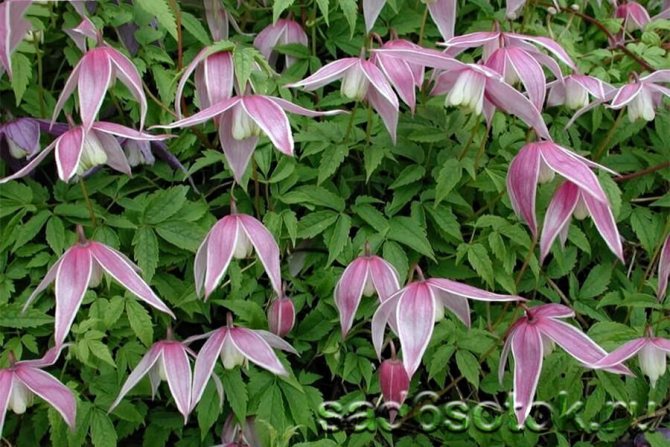

Duchess alpine variety Willy
This species grows best in shade or partial shade. For the winter, the shoots are shortened.
A blue-purple variety blooms in May "Pamela Jackman", blue Francis Reeves, white-pink Willie... Blooms profusely in April-June pink "Pink Flamingo".
Siberian prince
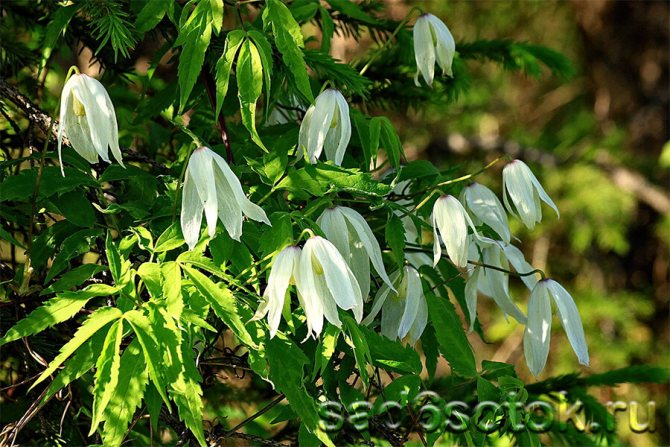

Unpretentious look with fragrant flowers. It can grow both in the light and in partial shade. An excellent choice for planting - the prince of the variety "Riga" with white flowers 5-7 cm in diameter.
Prince of Okhotsk
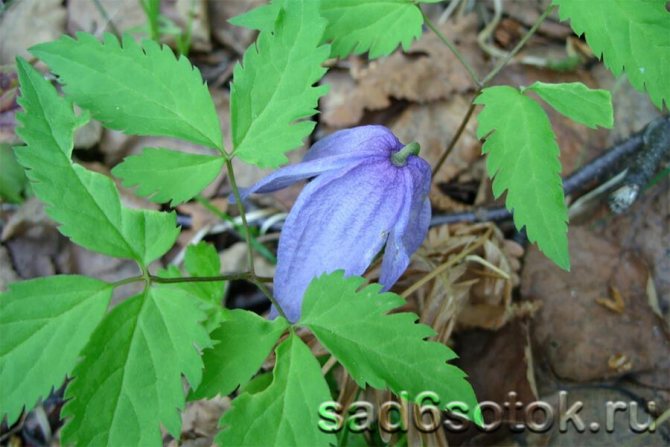

The most frost-resistant species from the forests of Primorsky Krai. Blooms in June on last year's shoots with blue or purple flowers.
Decorative prince "Tag Lundell" with purple flowers 5-7 cm in diameter.
We also recommend that you read the article "Climbing flower plants", it also describes other types of climbing flower vines.
Description and preparation
The Siberian prince has woody shoots up to 3 meters tall, complex leaves with long twisting petioles and white or yellowish large bell-shaped flowers.There are varieties of prince (Okhotsk, large-petaled) with flowers of a different color: purple, pink, blue, violet. The herb of Siberian prince is used as a medicinal raw material. Harvesting is carried out during the flowering of the plant, as well as during the ripening of the fruit. In the process of harvesting, the upper, non-lignified parts of the shoots are cut off, dried in the sun, and then dried in the shade or in a well-ventilated warm room. The dried herb is stored in cloth bags or glass jars with lids. In its raw form, the prince cannot be used, since it contains poisonous substances. Dried prince is non-poisonous.
Landing in open ground
In the middle lane, the prince is planted in the spring - in May or in the fall - in early September.
For planting, they dig spacious holes 60 cm wide and deep. Drainage 10-15 cm thick is placed at the bottom of the hole and partially filled with loose and fertile soil. Cuttings or seedlings are placed on an earthen mound in the center of the pit, the roots are straightened and covered with moist earth. The root collar should be 5–8 cm deep for young specimens, and 10–12 cm for mature plants.
A layer of clean river sand mixed with wood ash is poured around the root collar, and the remaining soil is poured on top. This will prevent water from accumulating at the base of the bush during watering. After planting, the soil around the plant is compacted and watered. The distance between tall vines should be at least 1.5 m, for short princes - 0.7-1 m.
Watering
Plants are watered abundantly once every 7-10 days. In the heat - 2-3 times a week. 2-3 days after watering, the soil around the bushes is loosened.
Top dressing
Vines are fed at least 4 times a year. In early spring, nitrogen fertilizers are used, during the budding period and after flowering, organic and mineral dressings are combined. In September, autumn fertilizers are applied with increased doses of potassium.
Prop and trim


Support is needed to grow a prince
Light but strong supports are installed for plants. After planting, the shoots are immediately attached to the support. The garter will set the right direction for growth. The bush will look beautiful, be less damaged and suffer from fungal diseases.
The princes do not prune in the fall - they bloom profusely only on the shoots of the previous year. Only weak shoots in thickened bushes are cut off. In the spring, to maintain a decorative appearance, part of the shoots that previously had flowers are removed.
Composition and properties
Siberian prince contains: ascorbic acid, alkaloids, flavonoids, cardiac glycosides, saponins. The seeds of the prince are rich in oil. The plant has a tonic, antitumor, antibacterial and stimulating effect.
In folk medicine, the Siberian prince is recommended for:
- colds, fever;
- tuberculosis;
- pneumonia;
- oncology;
- epilepsy;
- fragility of blood vessels (to strengthen them);
- heart weakness;
- dizziness, headache;
- chronic catarrh of the stomach;
- ascites;
- liver diseases;
- metabolic disorders;
- diabetes mellitus;
- edema;
- Do not lie;
- paralysis;
- joint pain, rheumatism.
Infusion (general recipe):
- 2 tbsp chopped grass of Siberian prince;
- 500 ml of boiling water.
Pour boiling water over the herb and leave to infuse for three hours. Strain. Take 1-2 teaspoons three times daily before meals.
- 3 g of dry herb of Siberian prince;
- 200 ml of boiling water.
Related article: Common sedge - useful properties, description
Pour boiling water over the prince and steep for 30 minutes. Strain. Take 1 tablespoon of the infusion three times a day after meals. To obtain an infusion from ascides and cystitis, 200 ml of boiling water is poured over 1 teaspoon of the herb and infused for 30 minutes. Take the infusion in the same way as in the previous recipe. Infusion for oncology:
- 1 tsp chopped grass of Siberian prince;
- 2 tbsp. boiling water.
Pour boiling water over the little prince, let it brew for an hour and strain.Take 1 tablespoon three times a day. Broth (general recipe):
- 1 tsp chopped grass of Siberian prince;
- 1 tbsp. boiling water.
Pour boiling water over the prince and simmer for half an hour. Then remove the broth from heat, let it brew for 10 minutes and strain. Top up with boiled water to the original volume. Take 1 tablespoon three times daily after meals. The broth of the prince has tonic and stimulating properties.
Headache decoction:
- 1 tbsp chopped prince herb;
- 1 tbsp. boiling water.
Pour boiling water over the prince and boil over low heat for 15 minutes. Then remove the broth from the stove and let it brew for 2 hours. Strain. Take 1 tablespoon three times a day. Also, this broth will help with colds, headaches and dizziness. Fortifying tincture:
- 100-150 g of chopped dried herb of Siberian prince;
- 500 ml of vodka or alcohol.
Pour vodka over the grass and let it brew for three weeks. Shake the container with the infusion periodically. Strain the finished tincture. Take 30-40 drops, diluted in a little water, three times daily before meals. Tincture for oncology and tuberculosis:
- crushed dry grass of Siberian prince;
- vodka.
Fill a dark glass bottle 1/3 with a prince, and then fill with vodka to the top. Let it brew for 14 days. Then strain. Take 2 tablespoons of the tincture, diluted in a little warm water, three times a day.
Joint pain bath:
- 1 tbsp. crushed dry grass of Siberian prince;
- 15 liters of boiling water.
Boil water, add the herb to it and let it brew for an hour. Then pour the strained infusion into a water bath. The bath water temperature should be 35-37 ° C. Take a bath for 15-20 minutes 2-3 times a week for joint pain, rheumatism, neuritis.
Reproduction
Seed propagation
Seeds are stratified before sowing. This shortens the germination time. Without treatment, seeds germinate within 8 months, after treatment - in 2 months. The prepared seeds are sown in April in a mixture of earth and sand (2: 1). The boxes are covered with glass, put in a warm place, watered and ventilated. After the appearance of 4–5 pairs of true leaves, the seedlings dive into the beds in the loose and fertile soil. The root collar of young princes is buried by 2-3 cm. The bushes are planted in a permanent place after wintering the next year. For the winter, the seedlings are cut and hilled.
Cuttings
The best results are obtained by cuttings in June-July. Take the middle part of the shoots 4-6 cm long with one or two nodes. They are treated with a growth stimulant and planted in a greenhouse in wet sand. The cuttings are watered in dosage. The air temperature in the greenhouse is maintained within the range of 20-25 ° C. Rooting lasts 20-30 days. The seedlings are transplanted into separate containers or grow pots. The next year, they are planted in the ground in a permanent place.
Dividing the bush
This method is most often used to rejuvenate adult plants. In April (before the beginning of the growing season) 5-6-year-old overgrown bushes are dug out with a clod of earth, trying not to damage the roots. The plant is divided into several parts, each of which must have renewal buds and part of the roots. Delenki are planted in prepared pits, deepening the root collar by 8-10 cm.
Reproduction by layering
In the spring, grooves 5–10 cm deep and equal to the length of the rooted parts are dug near the intended shoots. The shoots are placed in a groove, covered with earth, leaving the ends outside. Layers are watered regularly. The next year, they are separated from the mother bush and transplanted to a permanent place.
Care
Caring for this plant will not take much time. It is important to follow just a few rules, and the prince will truly be the king of your site or flower garden.
- You need to water once a week or one and a half. If the summer is hot, then 2 times a week is needed. Especially if the seedlings are young.The soil should be moderately moist, half a meter deep.
- Between watering, the soil must be loosened so that oxygen saturates the root system.
- You will have to feed and fertilize your princes twice a month. Mandatory before and after flowering. During the period of active flowering, top dressing is not done.
- Suitable as organic fertilizers: urea (10 grams per bucket of water), mullein and chicken droppings, and mineral fertilizers: full fertilizer (10 - 20 grams per bucket of water) and nitroammofosk (10 grams per bucket of water). In regions with a harsh climate, wood ash is also added under each bush.
- Liana can be sprayed with urea in the spring or full mineral fertilizer.
- Be sure to water and mulch the plants with sawdust, straw, vermiculite or peat.
- These plants need support. Therefore, even before planting, think about how your prince will grow, what its branches will cling to.
- Princes reproduce by cuttings and seeds.
- Pests and diseases are also not alien to these plants (powdery mildew, root nematode, brown spot). To protect the vine, you need to follow the rules of watering and fertilization. It is recommended to periodically inspect the plants.
Pests and diseases
Of the pests, they pose a threat root-knot nematode, mealybug, slugs and snails, as well as mouse and moles. From nematodes, 30–40 days before planting, the soil is treated with special means, the mealybug is destroyed with karbofos. Slugs and snails are harvested by hand or sprayed with metaldehyde. Spruce branches laid out around the bushes will scare away rodents during wintering.
Princes take up little space when planting and can grow where trees or shrubs cannot be planted. They're not only good for vertical gardening. With the help of semicircular and raised supports, princes are grown as ground cover plants.
For more information about the features of growing a prince, see the video.
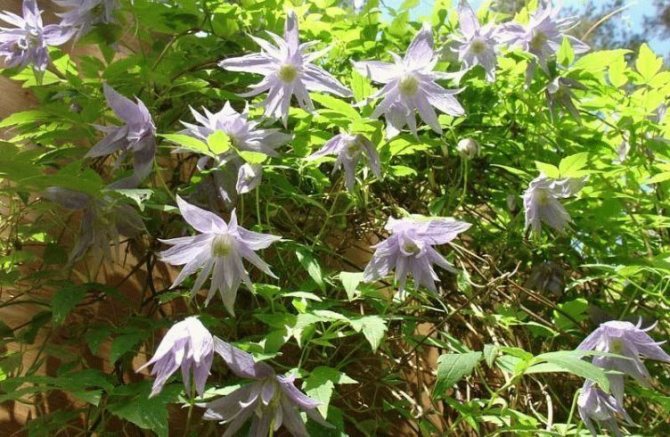

For several decades, garden plants have been popular with woody stems-vines. They are firmly attached to vertical surfaces and create an exquisite landscape design, hiding possible shortcomings of the infield. One of these plants is the prince, it is firmly attached to the support, and during the flowering period it grows overgrown with many "bells".
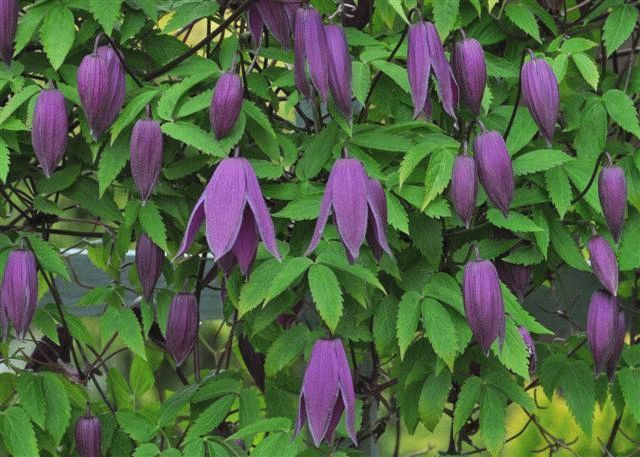

Major diseases
The princes are susceptible to some types of diseases, such as powdery mildew, rust, and spotting. In addition, it is necessary to remove various pests in time - snails and slugs. To protect against rodents, it is recommended to cover the flowers with fir branches for the winter. Tip: Spraying the plant with karbofos will prevent the formation of a mealy worm.
Powdery mildew dominates all parts of the plant. Leaves and shoots affected by it begin to dry out. A characteristic feature is the formation of a white coating on them. All diseased shoots must be removed and burned to prevent further infection. Spraying with whey or aqueous solutions with the addition of ash, mustard powder, liquid soap and baking soda will help prevent the onset of the disease.


Rust overcomes all parts of the plant above the ground. This disease can be identified by the presence of swollen red spots. Control methods are the same as with powdery mildew. Spraying with a suspension of poly-carbacin can be used.
Brown spotting usually begins with young shoots and leaves. The formation of brown spots threatens the death of the entire plant. It can also appear as white specks with a purple outline on fresh leaves. To prevent this disease, the plant is treated with a 0.1% solution of copper or iron sulfate.
Description of the garden plant
Knyazhik is a liana of a shrub species. She has woody stems and they are firmly attached to the vertical mounts. The plant grows up to 3 meters in height.The prince is very often confused with clematis, but unlike the latter, it differs in flowers that resemble bells in shape.
It is important to know that the prince is not a one-of-a-kind plant, it is a genus that includes different varieties. In the northern European and Siberian forests, you can find 8 types of prince. In the vastness of Russia, such species are mainly grown as: large-petal prince, Okhotsk and Siberian. Florists grow the Alpine prince from the varieties of the near and far abroad.
Just like clematis, the prince is afraid of the wind and does not feel well in direct sunlight, especially in the hot summer period. Basically, last year's shoots begin to bloom, and this process begins in the second half of May and lasts about a month. May bloom a second time at the end of August. After flowering, the bush is overgrown with seedlings. It does not recognize pruning, although it is highly frost-resistant, which makes it possible to leave the vines on a support. The plant is not whimsical and can grow in any soil, however, it is better to choose a planting site with an optimal rather than a high level of moisture.
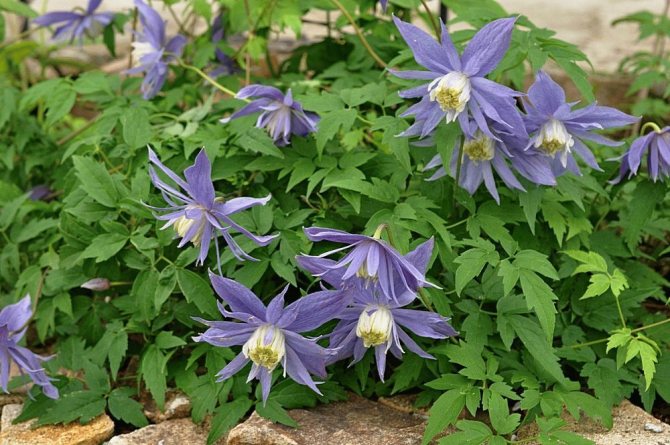

The prince belongs to the buttercup family, has odd-pinnate leaves. The flowers are about 10 centimeters in diameter, broadly bell-shaped with petal-like sepals. The flower petals of the prince are small and almost invisible, below they are bordered by bright calyx leaves.
Although the prince is similar to clematis, it looks much more elegant. Abroad, in particular in Canada, breeding plants are even bred and distributed all over the world. Through the efforts of florists, new varieties have appeared for the Moscow region:
- Maidwell Hall - differs in a delicate lilac color, there are light blue and terry shades.
- Pink Flamingo - as you might guess from the name, it blooms pink, the first flowering period falls in April June, a month later it blooms again.
- Pamela Jackman - blooms with bluish-purple bells, is considered one of the tall varieties, liana can reach 3 meters.
- Willie - bells are more drooping than other representatives, white and pinkish shades prevail during flowering. The peak of flowering begins in May.
- Francis Reeves - a feature of this type of flower petals, it reaches 8 centimeters in length, which is somewhat larger than that of other princes. The flowers have a bluish tint.
- Estrella - refers to the large-petaled princes, the height of this plant can reach 4 meters, the flowers have a calm light blue color.
- Memm - flowers have double corollas and are distinguished by a sparkling white tint.
- Rosie O'Grandy - pink flowers, somewhat reminiscent of the Pink Flamingo variety, but belong to the large-leaved princes.
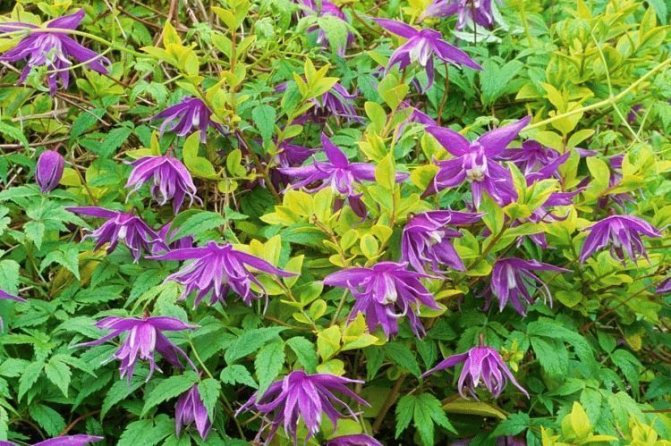

Main types
The breeding species presented above, of course, are actively used in landscape design, but do not forget about the main varieties of the prince:
- Alpine prince - mainly it can be found in forests and thickets on the banks of rivers. It is a 2-meter liana, which is attached to the support and hangs down with graceful garlands. The leaves are small, about 4 centimeters long. The flowers are both blue and purple, in shape they resemble a bell. The sepal is shaped like an ellipse, which is pointed at the end. The outer part is slightly lowered, and the petals are 2-3 times smaller than the sepals. Varieties of the Alpine prince are distinguished by white and pink flowers. The most common varieties are Flamingo, Willie, Jackman and Francis Reeves.
- Siberian prince - This plant can be found in the forests and in the Chinese Tien Shan highlands. This prince is very fond of forest edges, rocks and thickets of coastal zones. This prince is not just a beautiful plant, but in the wild world it is considered an endangered species, therefore it is protected in reserves. It reaches a height of 3 meters. The flowers are large and represent a drooping white bell. But even when flowering ends, the bush does not lose its natural decorative appeal, since beautiful fruits appear on it.
- The large-petaled prince is the birthplace of this plant in the countries of the Far East and Siberia, where the plant was chosen by the forest edges. Flowers are formed by combining 4 blue-purple petals. Such varieties as Memm, Estrella, Grandi, Hall were bred from this species.
- The prince of Okhotsk is the birthplace of this plant in Siberia, China and Primorye. The prince of this species can be found on forest glades and rocky slopes. The leaves of this plant are three-triplet, and the flowers look like a wide purple-blue bell. This species is considered the most decorative among all members of this family.
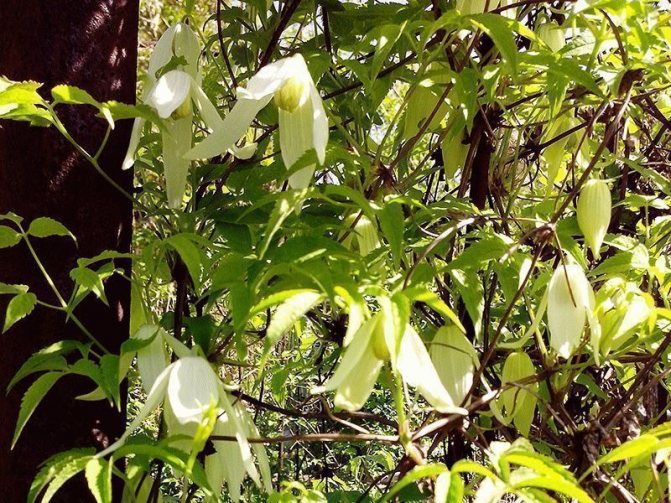

Features and application of the plant
The prince belongs to the Buttercup family and is a unique plant - it climbs trees, forms thickets and has excellent decorative properties. Its leaves with curling stalks provide a spectacular appearance, and bell-shaped flowers give solidity and even some stiffness.
Shoots of the Siberian prince can grow up to three meters, twisting around trees, bushes or pillars. His flowers are usually white or with small inclusions of yellow. There are varieties with bells in pink, blue, purple, or purple.
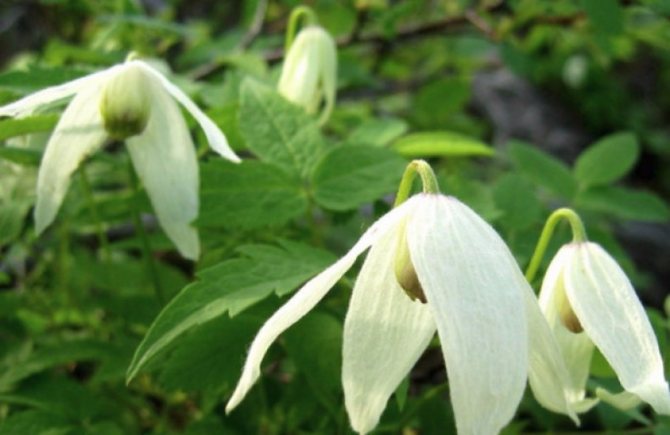

In folk medicine, grass is used, which should be harvested during the period from the beginning of flowering to the formation of fruits. Siberian liana is used in various recipes - from ordinary tea to medicinal infusions for oncology.
Related article: Protium - useful properties, description
Growing and care
Before you plant the prince, you need to decide on his place. The location of the prince should be chosen based on the characteristics of this plant. Although the prince is light-loving, he cannot stand the sun, under direct hot rays, especially in the sultry season, his leaves begin to shrink. So when choosing a landing site, you should give preference to a sunny, but relatively shaded place. For example, the eastern slope, the slope of which does not exceed 50 degrees. Also, the landing site should not be windy, as the flowers will quickly fly around. The plant is frost-resistant, therefore it can winter without covering.
As for the soil, the plant is not particularly whimsical and almost any soil will suit it. The main thing is that it is not swampy and has a high level of moisture. It is good if the earth is permeable and loose. Loamy, neutral or poorly cleaned soil is perfect for a prince.
Healing properties
Like many other plants that have managed to survive and develop in harsh natural conditions, the prince has useful substances in its structure that can be used to treat the following diseases:
- diabetes mellitus;
- rheumatism;
- respiratory system diseases;
- tuberculosis;
- headaches;
- joint pain;
- paralysis;
- diseases of the gastrointestinal tract;
- oncological diseases.
As for oncology, in this case, the culture is used to treat and prevent tumors of completely different organs (for example, stomach, intestines, kidneys, liver), but in any case, it is very important to consult a competent specialist before using it.
Princes: planting, reproduction and care
Princes for any florist are a unique find. The beauty of the buds and the size of the vines are combined with the amazing unpretentiousness and winter hardiness of these plants. But even despite the simplicity of cultivation, you need to know the secrets of planting and the nuances of reproduction. Correct agricultural technology will help to better preserve the plant and get a lush flowering when transplanting.


Landing of the princes
In order for the landing of the princes to be successful, several simple but important recommendations must be followed. First of all, you should choose the best place for the princes. A hole is dug of suitable size and filled with nutritious soil. The seedling itself needs to be pruned, and the stems must be straightened and laid down during planting.
Place for landing princes
The princes are forest plants, therefore it is advisable to find a place for them in partial shade in the garden. For example, on the east or west side of buildings. The prince will put up with a place in full sun, except that it will fade a couple of days earlier.
Alpine prince
- the most resistant to cold among modern varieties. It can be used to cover the north side of any building, it perfectly withstands absolute shade and cold north winds.
Landing pit for princes
When planting a seedling, a pit measuring 70 * 70 * 70 cm is prepared. A layer of gravel, expanded clay or sand-gravel mixture 10 cm thick is poured onto the bottom. Then they are covered with a layer of fresh horse manure of 20 - 30 cm. By the time the roots of the seedling reach it, it will completely grind and become an excellent fertilizer.
The remaining volume is filled with soil mixture: 2 buckets of compost, "native" soil from the site, 3 glasses of ash, 1/2 glass of double superphosphate, 1 glass of bone meal and 1/2 glass of complex mineral fertilizer. All components are thoroughly mixed (it is more convenient for me to do this in a wheelbarrow, in parts) and poured into the pit.
They make a depression for the seedling in such a way as to deepen the root collar by 10 cm. It is also useful for the seedling to create a capsule of river sand in order to isolate the roots from fertilizers and not burn them.
Pruning princes before planting
Regardless of the height, any prince sapling is cut in half before planting. This technique improves rooting and stimulates the formation of new roots. I don't throw out the parts of the cut shoots, but the cuttings and root them next to the bush.
The location of the stems of the princes when planting
When planting a prince in open ground, there is another important point - this is the location of the stems. I gently tilt each stem in different directions (like the sun's rays) and put it in the dug grooves 5 cm deep, leaving only the uppermost leaves on the surface. I fall asleep with river sand, and on top I put on a small stone for a better connection with the ground. So each shoot forms its own powerful root system, and after 2 years a gorgeous huge bush is obtained, which is not afraid of any frosts.
A sure sign that the vine has begun is the formation of new shoots from the axils of the leaves and from the root collar after two weeks.
Caring for the princes
Special care for the princes is required in the first year of planting, when you need to monitor the ratio of pancakes shoots and the size of the root system. In the future, it will only be necessary to direct the shoots around the opera, carry out sanitary pruning, and give top dressing.
Caring for princes in the first year of planting
For the first year, I periodically pinch the ends of the shoots as soon as they reach a height of 20 cm, otherwise there will be a rapid growth of shoots to the detriment of the roots.
It is important already when planting princes to take care of constant support for them, because for the winter the shoots of the plant are not cut off. From the first year of life, the princes give perennial shoots, which continue to grow in subsequent years, so it will not be possible to change the support, say in a couple of years. To do this, you will have to cut off all the shoots to zero.
In the second year after planting, the princes do not require attention.
It is only necessary to direct the shoots to the support in time and carry out light sanitary pruning in early spring or autumn.
Top dressing when caring for princes
The princes grow in one place for a long time, the main thing is to provide them with fertile soil when planting and mulch with compost every spring. If the compost is well prepared and contains various microelements, such nutrition is enough for the liana, no other feeding is required.
Beautiful princes
Dukes and clematis belong to the buttercup family. They are so similar that some botanists classify them as one genus - Clematis. The difference between plants is only in the fact that the flowers of the prince have small and almost invisible petals, bordered from below by large brightly colored calyx leaves.Clematis has no petals at all, but only a differently colored cup of 4-8 leaves in different species, which we take for the flower itself.
Alpine prince - Atragene alpina L. Grows in Central Europe along the banks and rocky cliffs of rivers, in shrub thickets. Liana, rising to a height of 3 meters, attaching itself with long twisting petioles to the support and hanging from it with thick garlands.
The flowers are broadly bell-shaped in shape, 2-6 cm in diameter, azure-blue or bluish-purple in color. The prince blooms in May-June. Numerous, collected in the head, fluffy fruits ripen in August-September. Has varieties (forms) with pink and white flowers.
Varieties with flowers of various colors:
- ‘Pink Flamingo’ (‘Pink Flamingo’) - liana 2-3 meters high, pink flowers, drooping 6-7 cm long. Abundant flowering in April-June, repeated single flowers in July-August. First trimming group.
- ‘Pamela Jackman’ (‘Pamela Jackman’) is a 2-3 m high liana, blue-violet flowers, drooping, 4-5 cm long. Flowering on last year's shoots in May. First trimming group.
- ‘Willy’ (‘Willy’) -liana 2-3 m high, flowers from white to deep pink, drooping, 5 cm long. Abundant flowering in May. First trimming group.
- ‘Francis Rivis’ (‘Francis Rivis’) - liana 2-3 m high, blue flowers, drooping with long (5-8 cm) petals. Blooms profusely in May-June. First trimming group.
Recommended for vertical gardening of low objects, fences and tree trunks, planting among stones (for rock gardens). They deserve wide distribution in the more northern regions of the Russian Federation. In culture since 1792.
Grand Duchess - Atragene macropetala. Homeland - Eastern Siberia, the Far East, China, Korea, where it is found on the forest edges of coniferous and deciduous forests. Very rare in culture. It grows even on the Kola Peninsula in the Polar-Alpine Botanical Garden, but its culture is more reliable south of St. Petersburg.
Has the most intensely colored flowers. They consist of four oblong, up to 5 cm long, covered with soft hairs of blue-purple, and before blooming, even black-purple sepals and numerous linear forms of blue-purple petals of almost the same length as the sepals. This prince blooms in May-June, and the fruits ripen in July-August. It also propagates by seeds and cuttings, the rooting rate of which is over 50%. The 'Lagoone' variety is shown above.
Many varieties are known, mainly bred in Canada. In the conditions of the Moscow region, it is distinguished by active growth, it blooms very profusely on last year's shoots in May and early June.
Varieties with different flower colors:
- ‘Estrella’ (‘Estrella’) is a liana 3-4 meters high, the flowers are blue, with a double corolla, drooping, 4-5 cm long. It blooms profusely on last year's shoots in May-June, individual flowers appear throughout the summer. The first trimming group (regulating). Winter-hardy.
- ‘Memm’ (‘Memm’) - liana 3-4 m high, white flowers, with a double corolla, drooping, 4-5 cm long. Abundant flowering on last year's shoots in May-June, individual flowers appear throughout the summer. First trimming group.
- 'Rosy O'Grandy' ('Rosy O'Grandy') - liana 2-3 m high, pink flowers, drooping, 4-5 cm long. Abundant flowering on last year's shoots in May-June, individual flowers appear throughout the summer ... First trimming group.
- ‘Maidwell Hall’ (‘Maidwell Hall’) - liana 2-3 m high, blue-violet flowers, drooping, 4-5 cm long. Abundant flowering on last year's shoots in May-June, individual flowers appear throughout the summer. First trimming group.
- ‘Jean Lindmark’ (‘Jan Lindmark’) is a vine 2-3 m high, flowers are blue, bell-shaped, drooping, 4-5 cm long. Abundant flowering on last year's shoots in May-June, individual flowers appear throughout the summer. First trimming group.
- ‘White Swan’ (‘White Swan’) is a vine 2-3 m high, flowers are white, narrow, drooping, 3-4 cm long. Abundant flowering on last year's shoots in May-June, individual flowers appear throughout the summer. First trimming group.
Prince of Okhotsk - Atragene ochotensis Pall. It grows in Eastern Siberia, Primorye, China and North Korea, found in coniferous and deciduous forests at an altitude of 600-800 m, often on rocky slopes.
Shrub vine. Reaches 3 m. Flowers up to 8 cm in diameter are broadly bell-shaped, consist of 4-8 violet-blue or azure sepals softly pubescent outside and linearly pubescent and much shorter petals. Flowers appear in June, fruits ripen in late July - September.
Siberian prince - Atragene sibirica L. Grows in coniferous and deciduous forests from Karelia to the upper Volga and the eastern Urals, in Siberia, in the Pamir and Tien Shan mountains. Prefers forest edges and coastal thickets, rocky slopes and rocky sediments. This is the most beautiful liana of the Siberian taiga. Protected in reserves.
In appearance, the Siberian prince is similar to the two previous species, from which it differs in large size, color of flowers, in addition, in the timing of flowering: the Alpine prince blooms in spring, the Okhotsk prince - at the beginning of summer, the Siberian prince - at the height of summer, sometimes again in autumn. Their combined use allows you to create beautiful blooming compositions with different flowering periods and different colors. Cuttings give a high rooting rate.
Location and conditions
The princes are photophilous, but in the sun the flowers and leaves become smaller. Plantings must be protected from the wind, as the stems and large flowers are very delicate and can be damaged by the wind. The prince is winter-hardy, even in the north of the European part of Russia, he hibernates without shelter.
This plant is very unpretentious, it can grow on any soil, except waterlogged and waterlogged, but it is desirable that it be light, loose, permeable, with good drainage. Loamy, slightly alkaline or neutral, fertile soil is best suited for princes.
When is the best time to plant?
It is better to plant a prince in spring. You need to start with the preparation of the landing pits. Before planting, 5-8 kg of humus, rotted manure or compost, 50 g of granular superphosphate, 2-3 glasses of wood ash are introduced into the pit. If the soils are acidic, add 50-100 g of slaked lime. Broken bricks with a layer of 10-15 cm, crushed stone, vermiculite are placed at the bottom of the drainage pit.
In the middle lane and to the north, the best time for planting is May, and in autumn - the end of August and September. The soil is prepared for spring planting in autumn, and for autumn planting - a month before planting. The distance between very tall plants should be at least 150 cm, and plants of smaller species are planted at a distance of 70-100 cm.
It is better to plant two-year-old rooted cuttings and seedlings that tolerate transplanting well. Before planting, all shoots above the first or second pair of buds are cut off. The broken off parts of the roots must be cut off when planting; treat the rest with a weak solution of potassium permanganate and sprinkle with crushed charcoal or ash.
A mound of earth is poured at the bottom of the pit and the roots are spread on it. Then they are covered with moist earth. The earth is compacted, watered and mulched. When planting, the root collar should be deepened by 5-10 cm for young seedlings and by 10-12 cm for adult plants. On heavy soils, it is buried by 5-8 cm, on light soils - a little more. This protects the root collar in the north from freezing, and in the south from overheating.
From infection with fungal diseases, the root collar is sprinkled with a layer of sand (bucket) mixed with wood ash (250 g), crushed charcoal and watered with a 0.25% solution of potassium permanganate. If buds appear in the first year after planting, then they should be removed for better plant engraftment.
We take care of the princes
The princes are watered after 7-10 days so that the soil is soaked to a depth of 40-50 cm.2-3 days after watering, the soil is loosened to retain moisture. In extreme heat, watering should be done two to three times a week. Also, the princes should be thoroughly watered before winter.
Top dressing on personal plots is carried out at least twice a month. The first feeding is carried out at the beginning of shoot growth and during budding, the subsequent ones after flowering and pruning. From organic fertilizers, urea (10 g per 10 liters of water), mullein (1:10), bird droppings (1:15) are introduced in liquid form. From mineral fertilizers, complete fertilizers are applied (10-20 g per 10 l of water) or nitroammofosk (10 g per 10 l of water).
Protecting from misfortunes
Powdery mildew. Most common in the south, it affects all parts of the plant. A white cobweb bloom appears on the leaves, leaves and shoots turn brown and dry. Control measures: collection of fallen leaves, pruning of diseased shoots and their burning is carried out; treatment with drugs for fungal diseases is recommended.
Rust. It also affects all aerial parts of the plant, on which reddish-yellow spots are formed - swellings. Control measures: spraying with preparations for fungal diseases.
Brown spot. Only leaves are affected, on which brown or white spots with a purple border are formed, and black dots appear on the surface of the spots. The defeat of shoots begins with young leaves and can lead to the death of the entire aerial part of the plant. Control measures: to combat brown spot in early spring and late autumn, the plant is treated with copper or iron vitriol (0.1%), Bordeaux mixture (0.5-1%), copper-soap emulsion (0.2-2,%), topsin -M (0.1-0.2%); the affected plants are completely cut off and burned, the ground around them is sprayed with a 0.2% solution of foundationol or a weak solution of potassium permanganate.
Gall nematode. Forms swelling on the roots. Control measures: it is recommended to treat the soil with nematogon or carbothion 30-40 days before planting.
Slugs and snails. Leaves are damaged. Control measures: it is necessary to collect pests and destroy the eggs laid by them; spraying the soil with metaldehyde (0.5-1.5%).
Mealybug. Damages leaves and shoots. It is effective against it to spray with karbofos (0.3%).
The seeds are mixed with sand in a ratio of 1: 3. The mixture is moistened and taken out under the snow or in a refrigerator with a temperature of about 5 ° C. This technique shortens the germination time. So, without stratification, the Alpine prince from sowing to germination takes up to 250 days, and with stratification, its duration is less than 70 days.
For sowing and picking, which is carried out at the stage of 3-4 pairs of leaves, the ridges are prepared from a mixture of 2 parts of sod land, 1 part of humus, 1 part of leafy soil and 0.5 parts of sand and peat. The distance between the plants being dived should be 3-4 cm, between the rows - 25-30 cm. The dives are shaded with shields and watered as needed. The aisles are loosened and mulched after the appearance of new 2-3 pairs of leaves.
In the middle lane, it is better to divide the bush in the spring in April, before the start of the growing season. Bushes 5-6 years old with a large number of shoots are dug out with a lump and, trying not to damage the root system, they are divided into several plants, so that each of them has roots and buds of renewal. Then the plants are planted in pits with fertile soil, deepening the first shoot node to a depth of 8-10 cm. The number of new plants depends on the degree of development of the mother bush.
When propagating by layering in the spring, several grooves 5-10 cm deep are dug out in the radial direction from the bush. The shoots are placed in the grooves and covered with earth. The end of the escape is brought out. Layers are watered and fed. After a year, the rooted layers are separated from the mother plant. They are cut between the nodes into individual plants, which, after planting, can bloom in the very first year.
Reproduction of princelings by cuttings gave the best results when taking cuttings in late June - early July. Rooting is carried out in greenhouses. The substrate is a layer of expanded clay 10-15 cm.It must be covered with 7-8 cm of washed river sand. Greenhouses are closed with filmy frames. The best conditions for rooting are created if the substrate is heated and watered in doses. The temperature of the substrate and air should be 20-25 ° C.
For cuttings, use the middle part of the shoot with one or two nodes. An oblique cut is made under the knot and a piece of shoot 3-6 cm long is left. The cuttings are planted at a distance of 5-10 cm, the buds should be 2-3 mm buried.
Good results are obtained when the cuttings are treated with a growth stimulant. Without treatment, the percentage of rooting is also high - 50-70%. Rooting of princes lasts 20-30 days.
Used for vertical gardening. The princes can be used to decorate trellises and trellises. Light, transparent, beautiful and at the same time comfortable and durable supports enhance the decorative effect and emphasize the dignity of plants. On such supports, the princes look like flowering carpets.
Curly princes take up little space when planting and can be planted where trees or shrubs cannot be planted. Their long shoots with varied leaf colors, many magnificent flowers and flowers and original silvery fruits can decorate large areas, providing shade, protection from sunlight and dust.
From Delenka: We will definitely publish a cheat sheet for you on the types of clematis pruning. For now, we just note that the 1st pruning group assumes that the plant is not pruned at all, only dried shoots are removed. In large-petaled clematis, it is also recommended to remove 2-3 upper nodes to stimulate tillering.
The genus has 8 species growing in the Northern Hemisphere. There are 3 species growing in Russia: large-petal, Siberian and Okhotsk. Of the foreign species, the Alpine prince is most often grown in culture.
Knyazhik is a shrub vine with a woody stem, clinging to the support with leaf stalks. Leaves are twice pinnate. Flowers are axillary, solitary, 10 cm in diameter, broadly bell-shaped with petal sepals. Fruits are numerous, fluffy, collected in the head.
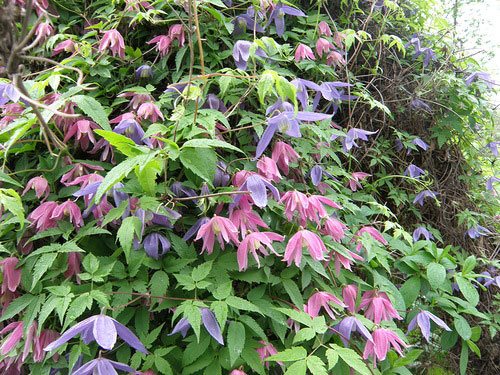

The prince and clematis belongs to the buttercup family. These plants are so similar that some attribute the prince to the genus - clematis. The difference is that the flowers of the prince have almost imperceptible petals, bordered from below by large colored calyx leaves. Clematis have no petals at all, but only a multi-colored calyx of 5-8 leaves.
The prince is more graceful than clematis, even small-flowered. The "soaring" flowers of the prince have not yet been appreciated by our growers. In central Russia, the prince is winter-hardy. By the way, the plant most often goes on sale under the guise of "clematis".
Princes in the garden
author Vantenkov V.V., title photo: Sofronov Alexander
The prince came to our gardens after useful Far Eastern plants - lemongrass and edible honeysuckle.
The genus Knyazhik (Atragene) unites 8 species, of which 3 species are found on the territory of Russia. The princes have long been cultivated and used in breeding work. Winter-hardy species are more often grown in Russian gardens: siberian prince
(Atragene sibirica - see cover photo),
prince of Okhotsk
(Atragene ochotensis),
grand prince
(Atragene macropetala),
Alpine prince
(Atragene alpina).
Imported planting material of garden forms and varieties of prince is often sold under the name "clematis". However, these are different plants. In regions with cold winters, spectacular princes are much easier to grow than large-flowered clematis.
The prince is one of the most unpretentious flowering perennial vines used to decorate the garden. Gazebos, walls of houses and fences entwined with princes with bright flowers of various colors against the background of green leaves look very elegant. The princes blooming for 1-2 months invariably attract everyone's attention!
Contraindications
The Siberian prince is contraindicated for:
- childhood and old age;
- pregnancy and breastfeeding;
- tachycardia and extrasystoles;
- individual intolerance.
Before starting treatment with a prince, you need to consult with your doctor. Attention! In its raw form, the prince is poisonous, therefore, even in the absence of contraindications, it must be used only in dried form.
- Spring chistyak
Spring cleaver (buttercup cleaver, spring buttercup, etc.) is a perennial herb of the Buttercup family. It is poisonous! It grows almost everywhere in ...
Field Yaruk
Field yarutka (toad grass, money box, etc.) is an annual herb of the Cabbage family. It grows almost everywhere on the territory of Russia: ...
Nut lotus
The nut-bearing lotus is a perennial amphibian plant of the Lotus family. Refers to relict. It grows along the shores of reservoirs and shallow waters in Japan, ...
Mulberry
The mulberry or mulberry tree is a deciduous woody plant of the Mulberry family. In nature, it grows in the European part of Russia, in the North ...
Reproduction of princes by seeds
A long time ago, collecting my collection of garden vines, I repeatedly subscribed to the princes' saplings. But they either died on the way or came too late for the autumn planting in the garden ...
I managed to breed the princes only by sowing seeds. Already the first flowering of these seedlings (2 years after sowing) surprised me with the richness of the color of their graceful flowers! However, not all the seedlings of the princes I received outwardly corresponded to the botanical description of the species. With the help of literature, I was able to find out that various types of prince are easily pollinated. And hybrid princes are much easier to reproduce by seeds. Plants with unusual flowers are obtained from such seeds - more beautiful than those of natural species of prince. Sometimes the shape of their flowers and color are so exquisite that comparison with ... aquarium fish involuntarily suggests itself! In addition, as a rule, the flowering period of the resulting prince hybrids is significantly lengthened.
Seed reproduction of princes is very simple - it is enough to sow freshly harvested seeds in the garden in the fall (usually sown in a school). Seedlings appear next spring.
When sowing in spring, the seeds of the prince are recommended to be stratified. For example, the seeds of the large-petalled prince are stratified from about mid-February - usually fresh seeds need a 2-3-month period of stratification for spring shoots.
The seedlings of the princes at first need to be shaded a little and watered regularly. In the fall, the seedlings that have grown over the garden season are transplanted to a permanent place. After all, the princes develop very quickly, and a 3-5-year-old liana occupies a solid area (3-4 square meters).
I was convinced that after three years of life, the prince's creepers no longer tolerate transplantation, which is a pity ... My attempts to propagate adult princes by dividing the bush were also unsuccessful.
The main advice for seed reproduction of princes: already in the first year of the seedlings' life, choose the best specimens from the school for the "ceremonial" gardening of the garden. The rest of the seedlings can be used to create flowering "green screens": masking outbuildings, fences, etc.
Seed reproduction of princes allows you to get a lot of seedlings. Many gardeners I know have grown spectacular plants with such elegant flowers from my prince's seeds that I would give any terry clematis for such a flowering specimen!
Features of care, pruning and reproduction
The plant of the first year of life loves water, but will not tolerate its stagnation. Moisten the soil at least once every 7-10 days, and even more often in dry conditions. Then loosen the ground. Make sure the plants are mulched. As the crop grows, you can slightly reduce the watering intensity.
Feed the flower for a rich color and abundant flowering. Alternate between liquid organic and mineral nutrition. Apply fertilizer once a month after watering the prince.In total, 3 additional fertilizing will be required: during the development of the shoots, during the formation of buds and after the end of flowering. Regularly prune dry twigs and wilted inflorescences, shorten the remaining shoots by 1/3.
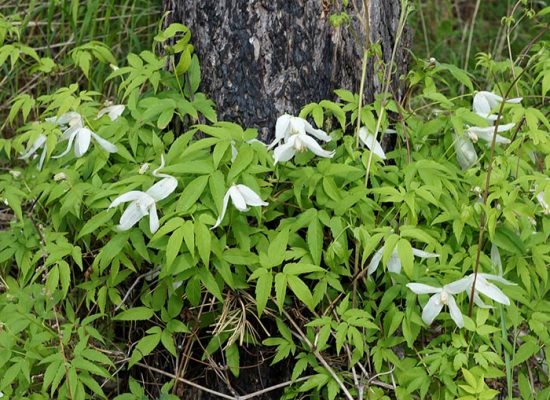

The prince needs rejuvenation every 5 years. If the variety is not resistant to frost, the shoots are removed from the support and covered with spruce branches, and the root collar is mulched. The prince is rarely affected by ailments and pests. Use fungicides and insecticides to combat.
You can propagate a culture like this:
- seeds. Before spring sowing, they are kept in the cold for 2 months. In autumn, the material is planted without preparation;
- division. Adult princes split up in April;
- cuttings. Requirements: length - 3-6 cm (taken from the middle part of the branch), the presence of 2 nodes. It is cut in summer and rooted in a greenhouse, in a mixture of expanded clay and sand. The top is wrapped in foil and stored until next year.
The simultaneous cultivation of the Alpine, Siberian and Okhotsk prince will make it possible to realize the dream of a continuously blooming corner of the garden. It will be alternately strewn with flowers of different shades from late spring to early fall.
Cultivation of princes
Any garden soil is suitable for growing princes, if only the water does not stagnate for a long time. Supports are needed only for young plants in the first years of life. Then the strengthened prince attaches himself, climbing the nearby walls, trees, and a fence.
Watering adult princes is also not necessary, because their long roots reach 5-8 meters. Therefore, it is advisable to water the seedlings of the prince only in the first summer, until their roots have grown stronger. Yes, I water young plants several times after planting from the school to a permanent place for quick rooting. However, in a very hot summer, my princes still receive little care. We have to water them, otherwise, in a drought, the earth cracking from the heat threatens to break the roots of plants. But on the other hand, in hot weather, the seeds of the princes ripen perfectly!
Adult princes do not need shelter before wintering. The princes do not need pruning shoots. Therefore, caring for these vines is less troublesome than for many flowering clematis.
Unlike clematis, the princes have another excellent quality - shade tolerance. Therefore, gardeners have the opportunity to grow princes in partial shade. Moreover, according to my observations, it is in such lighting conditions that these vines feel better. In penumbra, the flowers of the princes form much larger, and they last longer than those of plants located in the sun.
However, if there is a need to block the bright sun with the help of the prince's vines, this is also quite possible. In this case, I plant them with thickening (3-4 plants per meter). In the early years, young princes saplings, planted in a sunny place, need to be shaded (you can cover them with other plants - beans, beans, etc.) until they get stronger.
Liana prince lives in one place for 15-20 years. This plant does not need fertilizers. However, I was convinced that when feeding the princes (once a year - with a weak solution of a mullein, and occasionally with an ash infusion), the decorative effect of the vine is significantly enhanced. The brightness of the prince's flowers increases, and the leaves appear glossy.
general characteristics
Often the plant is also called clematis, although these vines are only relatives. They differ mainly in the structure of the flower.
The prince (Atragene) is a subgenus of lianas - perennials, which are part of the Lomonos genus and the Buttercup family (this combines the prince and clematis). Liana has other names: vine, loach, wild hop. In natural conditions, they grow in a temperate climatic zone, often in the north.
The sepals of this plant are large and they are bordered by completely invisible thin petals. Clematis have no petals at all. And what we take for them are sepals.
The word prince comes from ancient Greek and is translated as a tendril (clema). But it is precisely the antennae that this vine does not have.It clings to a net or support using twigs with leaves and petioles.
- This plant is referred to as shrub vines. The stems are ligneous.
- Leaves are twice or thrice pinnate.
- The flowers are single and axillary, rather large - about 10 cm in diameter. They look much more aesthetically pleasing than clematis flowering. They are also similar in structure to bells, on the branches they have a drooping shape.
- The fruits are collected in a fluffy head, there are quite a few of them on one bush.
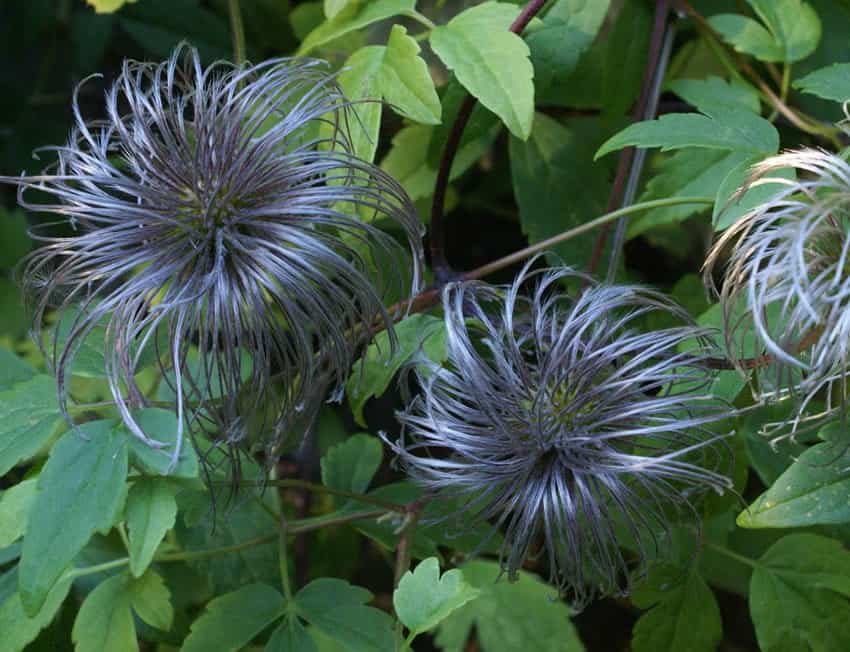

The princes grow very quickly. When clematis is just starting to wake up after winter, the prince is already turning green with might and main. The princes of several varieties look very beautiful - together they make up a very stylish composition and are able to decorate any flower garden or garden plot.
Precautions
It is worth noting that the juice of the princes is poisonous and, if it gets on the skin, can cause burns and allergic reactions. When working, flower growers use personal protective equipment - these are rubber gloves and a respirator. If clematis juice gets into the eyes, it is required to immediately rinse with water to avoid retinal burns. Garden shears and pruners, after working with the plant, are thoroughly washed and treated with an antiseptic composition.
It is important to monitor the condition of the princes throughout the vegetative period. The crown and leaves should not come into contact with delicate flowers such as petunia, violet, pansies, stock roses, as well as fruit and berry crops.
Subject to the above rules, liana hops will delight their owners with lush flowering for several decades.
The use of the prince
The princes are used for vertical gardening. Transparent, lightweight, beautiful and comfortable supports enhance the effect and emphasize the dignity of plants. On the supports, the princes look like flowering hanging carpets. When planting, curly princes do not take up much space and can be planted where it is impossible to plant shrubs or trees.
Levisia is a rare plant found in dry areas of North America. She has not been found anywhere else. Most of the species within this genus are now in culture, in the form of attractive ...
Winter Garden
In winter, a winter garden will become a corner of warmth and comfort in your home. A winter garden can be the most attractive space in your home - a sunny room with a variety of exotic plants. It was about winter gardens ...
Rod Rogersia has about 8 species native to Japan and China. Perennial ornamental deciduous plant. The foliage of Rogers is large, palmate-lobed. The flowers are white, collected in a paniculate inflorescence. Rogersia is a large, amazingly beautiful plant ...
Brunner is a wonderful perennial. Beautiful brunner leaves of frosty silver color will adorn your flower garden. Brunner flowers Of course, brunner blooms (her flowers look like forget-me-not flowers), but still the beauty of this flower is in the leaves. Brunner ...
The genus includes more than 600 species, mainly distributed in Asia, Europe, America and Africa. Bristlecone is a rhizome, perennial, less often annual, herbaceous or sometimes semi-shrub plant. Description of the stele The stems of the steep are straight. The foliage is located opposite ...
Varietal variety
As mentioned earlier, on the territory of Russia, princes are represented by 4 types:
- Alpine;
- Okhotsk;
- Siberian;
- large-petaled.
The homeland of the alpine species is Southern Europe. In the presence of high supports, it reaches 3 m in height. Buds are formed on overwintered shoots. The flowers are drooping, from 2 to 6 cm in length, formed between May and June, have a delicate purple color. By the end of the growing season, young branches lose their flexibility and become covered with tree bark. In regions with a long summer period, clematis blooms again at the end of the growing season (from August to September). To rejuvenate it, flower growers cut the lashes up to 2-3 knots from the root every 3-4 years.
The prince of the Violet Purple variety has purple-crimson flowers with a yellow center, their diameter is 5-6 cm. It is appreciated for its compact and neat appearance, the ability to grow in containers.
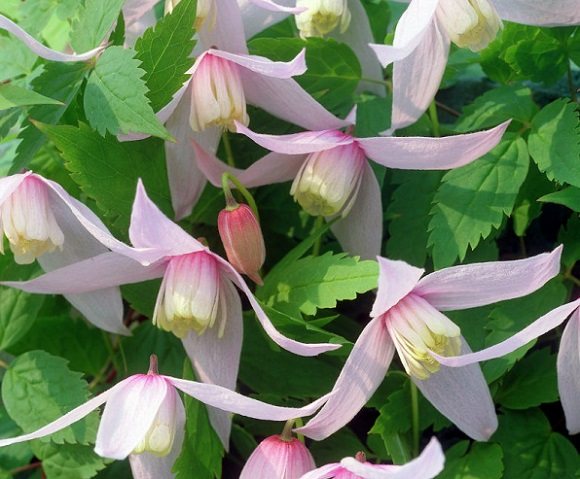

Willy's variety
For planting in the garden, beginners prefer to choose varieties:
- Willie;
- Cyanea with a velvety coating on the veins;
- Frankie;
- Light pink Pink Flamingo;
- Ruby with elegant foliage;
- semi-double Constance and others.
The Okhotsk species is considered the most frost-resistant. The varieties have elongated (up to 2-3 m) herbaceous stems, the area of distribution is the Primorsky Territory. The flowering period depends on the region of planting, it varies from May to the end of June. Vine buds drooping, flowers resemble bells, consisting of 4-8 sepals. They are formed on overwintered shoots. Petals can be blue, purple, azure color. In preparation for wintering, the stems are not cut off. But weigels have a positive attitude towards pruning, so at this time you should not forget about them.
- Siberian and large-petal species


Siberian prince
Siberian varieties of clematis are sung in poetry and prose of past years. They are often identified with wild hops and are described as very delicate and sophisticated plants. Distributed from the Urals to the Sayan Mountains, easily recognizable by the white water lilies of flowers and a large number of bees around them. They have a delicate sweetish aroma, thanks to which they are recognized as the best decorative vines for garden and park areas and summer cottages. They are characterized by high winter hardiness and can lie under the snow without damage to the vegetative system for more than 5 months.
In the shaded area, the flowering period is delayed for several weeks.
The large-petaled prince comes from the Pan-Asian countries (China and Japan). From there it was brought to the Far East, then the growing area spread to Western Siberia. This species is photophilous, resistant to direct sunlight. Differs in spectacular large purple flowers. The drooping buds have a double shape, reaching 4-5 cm in diameter. The flowering period lasts from May to June. It is considered the most whimsical representative; temperatures below -25 ° C are harmful for him. When preparing the garden for the winter season, the liana is stopped up to 2-3 knots from the root, the fresh cut is treated with garden pitch, and the plant itself is placed in a hole and covered with mulch.
Of the varieties it is worth advising:
- powerful Anders with abundant flowering;
- Ballet Skirt with a warm pink shade of petals;
- Ash Spider, suitable for growing in containers;
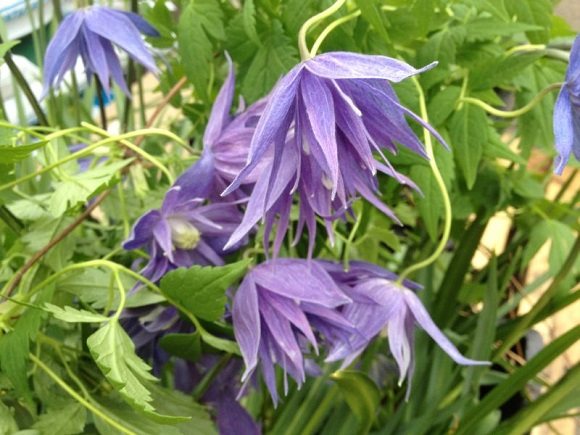

Lagoon variety - blue lagoon;
- Terry White Swan.
There are no problems with planting the prince and further leaving, the set of actions will be the same in relation to any of the above types.
Useful properties and contraindications
Only the Siberian prince has healing properties. Its alcoholic tincture, extract or dried flowers and shoots are sold in pharmacies. Fresh plant is not used.
Preparations based on it are considered antineoplastic agents. They also have regenerating, tonic and antibacterial properties.
Decoctions and infusions are prepared from dry raw materials, which improve the work of the cardiovascular system, metabolism. They help with inflammation of the gastric mucosa and relieve headaches.
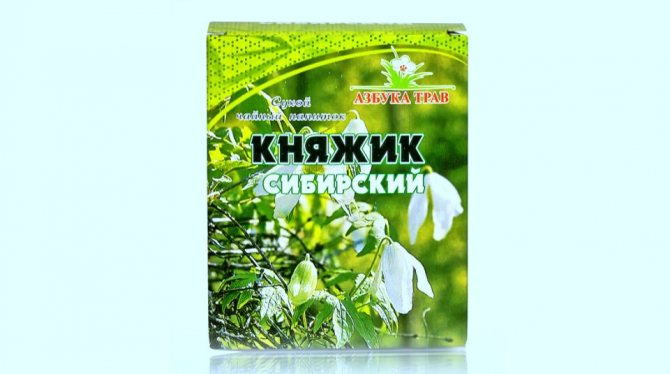

Herbal tea drink from Siberian prince
Since the prince is a poisonous plant, then before using it, you must consult a doctor and then withstand the dosage of the medicine. Strictly contraindicated in pregnancy, cardiac arrhythmias - extrasystoles and tachycardia.
Varieties of princes
There are over a hundred varieties of clematis. The princes, along with clematis, are able to decorate any garden. The most common types are:
They bloom for about 3 weeks. First, the Alpine prince begins to bloom, then the Okhotsk and, last of all, the Siberian. Planting these varieties together will create unique long-flowering compositions, and care behind them does not take much time and effort.
Some varieties of princes were brought to our country from Canada, having delicate shades of lilac, pink, white and purple-violet. These are Markham's Pink, Rosie Ogredi, Teige Landell, White Columbine. They are adapted to the conditions of central Russia and are winter-hardy species. On sale they can be found under the name "Clematis".
Read also: Useful composition and medicinal properties of chervil
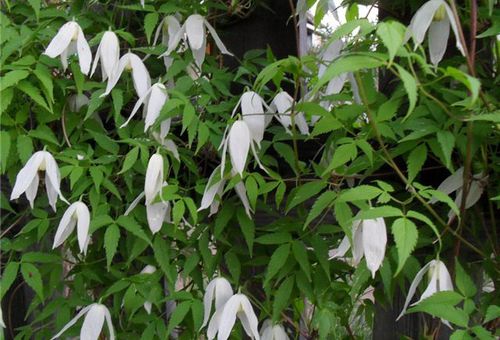

Prince Siberian
Varieties of princes for the Moscow region
Knyazhiki is a plant unique in its unpretentiousness and winter hardiness. Their delicate romantic buds adorn the garden from mid-May to the end of June, with the right choice of varieties. Terry and simple, blue and blue, yellow and white, pink and purple, two-tone and monochromatic - modern varieties of princes can boast of such colors.
Princes and Clematis
Although we are used to thinking of princes as a kind of clematis, this is not the case. Both vines belong to the buttercup family, and this is where their similarities end. Unlike clematis, princes are surprisingly undemanding and require minimal care from the gardener.
This vine brings a touch of romance and natural charm to any garden, regardless of its style. In partial shade and on fertile soil, they master any support up to 3 m in height in a couple of years.
Alpine prince
The first guest in the dacha gardens was the Alpine prince. This natural species of vine with simple blue flowers in the shape of a cross has been successfully transplanted into their gardens by enterprising gardeners from Central Europe. Subsequently, the Alpine prince gave a start in life to various modern varieties already with double flowers.
In the conditions of the Moscow region, all modern varieties of princes are winter-hardy.
Terry varieties of princes
Varieties with white double flowers (Albina Plena, White Swan) are considered more thermophilic. For them, such a landing is desirable so that from the north side they are protected by a structure from cold winds. In development, they lag slightly behind other varieties. For example, it takes not two, but four years for them to form a full-fledged lush plant in my garden. Otherwise, they are no different from other princes.
Photo: variety of prince Albina Plena (Albina Plena)
Of the pale pinks, the pink Swing and Pink Dream double varieties are great. Ballet Skert has a deeper pink color.
Photo: variety of prince Pink Swing (Pink Swing)
Terry soft lemon Lemon Dream also looks unusual. The Jiska variety boasts semi-double flowers in a deep blue color.
Photo: variety of prince Lemon Dream (Lemon Dream)
Unusual varieties of princes
The most unusual variety is Stolwijk Gold with deep blue flowers and lemon-colored foliage. The foliage retains its unusual color throughout the season.
Among princes with dark flowers, the Pearl Dream variety with rich dark purple flowers is interesting.
Photo: variety of prince Stolwijk Gold (Stolwijk Gold)
The most beautiful varieties of princes
Willy's variety is a surprisingly delicate prince with simple white flowers, at the base of which there is a crimson spot both outside and inside the flower. He requires a separate landing in order to show himself in all his glory, with other princes his beauty is lost.
The Janni variety has a two-tone color, its outer petals are pink, and the middle, consisting of densely packed inner petals, is lemon.
Photo: Willy prince's cultivar
Svetlana Samoilova, amateur florist
How to plant clematis?
It is better to plant the Alpine prince in open ground in the spring. The optimal time is mid-May. The plant is quite whimsical, so you need to choose the right place for planting. It should be in a small shade, be reliably protected from wind gusts and drafts.
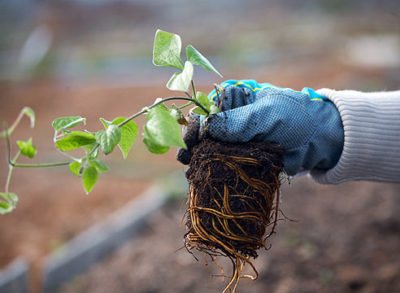

Particular attention must be paid to the soil. Lianas do not like heavy and acidic soils; fertile or loamy soils are considered optimal. It is important to ensure that the soil absorbs moisture well and is fairly loose. Clematis does not tolerate groundwater, as it can lead to root rot.To avoid this, it is better to plant a flower on a low mound. You can create it yourself. The root system of a green pet is well developed. It can be up to 1 m long.
Clematis, or prince, should be planted in a pit about 50 cm deep. It is recommended to organize a drainage system at the bottom of the hole, pouring out a small layer of rubble. All the soil obtained by digging a hole must be replaced with a special substrate. You can prepare it yourself by mixing:
- 1 bucket of fertile soil;
- 100 g of slaked lime;
- 0.5 buckets of leaf humus.
When planting, you need to evenly distribute the roots across the width of the pit. A layer of substrate approximately 15 cm thick is poured on top. It is important that the hole is not completely filled. The remaining mixture is periodically poured until autumn.
When planting vines along the walls of the building, you need to ensure that the distance between the seedling and the house is at least 40 cm. In this case, the water that flows from the roof during rain will not harm the plant. When planting several vines at once, it is necessary to ensure that there is a distance of at least 25 cm between them. When planting clematis in open ground, it is important to take care of the supports in advance that will support the lush flower garlands.
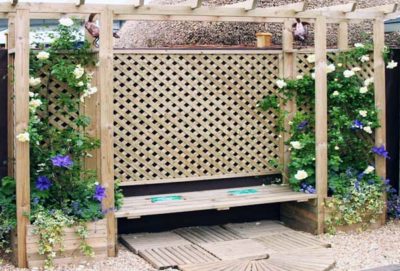

You can plant a plant in the fall. In this case, the same rules must be followed as for the spring placement. The only difference is that it is necessary to completely fill the hole with the substrate. The planted vine must be carefully covered for the winter.
The advantages of princes over other types of clematis
Boron hops are common in the wild. You can meet him at the edges of the forests among the thickets of bushes. Clinging with shoots to the trunks and branches of trees, the liana completely entangles them. In some mountainous regions of the Alps, whip-like atragenes fall from slopes and ledges, forming beautiful flowering curtains.
Adapted to the conditions of the wild, they are particularly unpretentious when grown in gardens and parks. Varieties of panicle hydrangea are more finicky in this regard. Among the main advantages it is worth noting:
- high winter hardiness of certain varieties;
- arbitrary wintering, in which the plant does not require seasonal pruning;
- resistance to frequent transplants;
- fast regeneration of the root system;


Lianas after flowering - bloom earlier than their counterparts (most varieties from mid-May);
- active growth rates, allowing for the season to create an extensive green curtain from prying eyes;
- abundant flowering even on depleted soils;
- resistance to sudden temperature changes;
- the presence of a glycoside in the fibers of the plant - a poisonous burning substance that can protect against the invasion of parasitic insects and fungal diseases;
- high nectar content in flowers.
Padalka (seeds) is distinguished by friendly germination. In species clematis, planting material must be stratified and grown at home to seedlings.
Which variety should you choose?
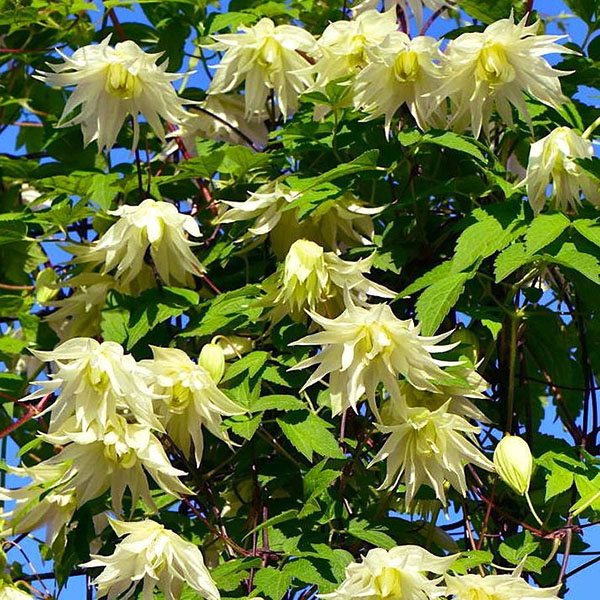

If we consider the eggs, the varieties of this plant are very similar in appearance, but have some distinctive features. The cultivar Ballet Skert also stands out with its pale pink flowers. It can be used to form living curtains of arches or trellises in the garden. The prince Lemon Dream of a gentle lemon shade also looks great. Its sepals are slightly elongated with wavy edges. The flowering of the plant occurs in May, and in the summer this phenomenon is repeated, but not so abundantly. The plant can be used as a ground cover crop.
How to make rockery (video)


Gardeners and the Alpine prince with beautiful flowers of a pink or purple hue do not bypass the side. His homeland is considered to be Central and Southern Europe. Flowering usually begins between May and June. If favorable conditions are created, then the plant, as in the case of other varieties, will bloom again in the summer. It is better to choose moist soil. The best location is in partial shade.
Knyazhiki: choosing the place and time of boarding
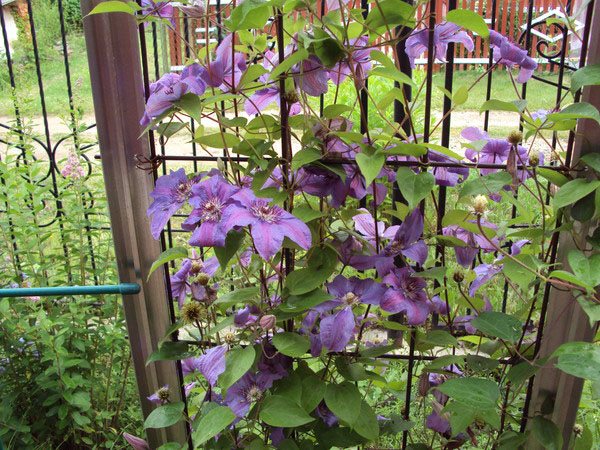

Caring for them is not so difficult, but you need to adhere to certain rules. For planting a plant, it is preferable to choose lighted areas, but if necessary, the Siberian prince, whose photos are presented in large numbers, can grow in partial shade, which also distinguishes it favorably from related clematis.
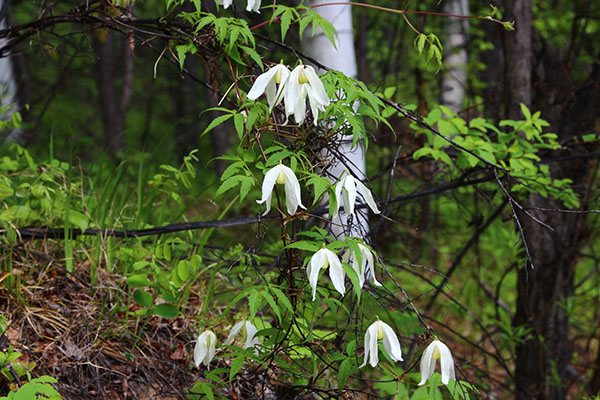

However, drafts should be avoided and care should be taken to protect against cold winds. Since the plant is a liana, support structures will need to be created. It can also be garden fences. During the winter, you can forget about caring for the prince, since this is a rather frost-resistant culture that does not require additional shelter.
The most favorable period for planting a prince in the garden is May.


For this, the end of August is also suitable. If you plan to buy princes of a variety for the Moscow region in Moscow, then it is worth considering that two-year-old saplings take root most easily. It can also be cuttings with a root system, but the same age. Before planting, the soil must be enriched with humus or ordinary manure. In order to disinfect it, you can use a solution of potassium permanganate. Liana will grow better if a drainage layer of about 10 cm is created. Soil preparation is carried out well before planting.
[collapse]
Growing environment
In our country, this plant is not yet very well known. It can be rarely seen in the wild. More often Knyazhiki are found on personal plots.
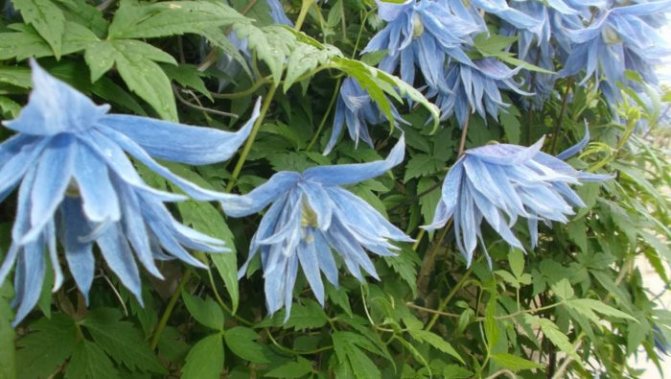

The birthplace of these beautiful vines is Central Europe. Here bushes grow in thickets or forests located on cliffs or rocky banks of rivers and lakes.
The most optimal regions for the growth of Knyazhikov are regions with a temperate climate. In Russia, the plant is used to decorate fences, arbours and arbors, which are in partial shade. It is important! Otherwise, the flowers of the plant will be small.
Plant pruning
Pruning clematis is a mandatory procedure. It prolongs flowering, allows you to give the plant a well-groomed appearance and beautiful shape. The procedure should be performed in early spring or before wintering. You need to choose a cloudless and dry day.
Pruning methods are directly related to the age of the plant. So:
- 1 Prince Alpine 1 year of life is cut off completely, all shoots are shortened by 25 cm. It is important to ensure that 2 buds remain on each stem. This is necessary in order to create additional vines. In the next season, the bush will be much more lush.
- 2C of older clematis, you need to remove all broken, diseased and dried shoots. Healthy stems are shortened by 10 cm.
There is also a universal method suitable for all plants, without exception. It involves pruning the bushes according to the principle through one: 1 stem is shortened in half, and 2 is cut so that only 2 buds remain on it. This is done with the whole plant. As a result, next season it looks much more well-groomed and lush.
Rating:
Description
If we consider this plant in more detail, then first of all it is worth saying that princes are considered quite close relatives of such a plant as clematis. They are referred to the Atragene group. They differ from their congeners quite a bit. The first thing that catches your eye is the longer vines, the size of which reaches 4.5 meters.
The princes bloom very early, in early May. However, there are earlier varieties that bloom from April to May. They can be used to decorate areas located in cities with a warm climatic zone.
The flowering of the princes is quite abundant, and if you look from the side, the bush is a blooming carpet of a huge size.
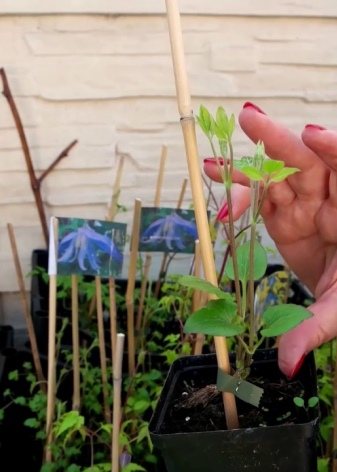

The vines of the plant are quite flexible and covered with carved leaves that stand out in a light green tint. They can be attached to any support with long petioles that twist in any direction.
The prince's flower is an elongated bud up to 9-12 centimeters in size.It looks a bit like a bell. They grow singly. The calyx itself consists of 5-7 sepals... The color can be very different and depends on the type of plant. They can be white, pink, or even blue. Flowering lasts quite a long time - from one to one and a half months. And at the end of August, fruits appear in place of flowers, that is, round boxes containing seeds.
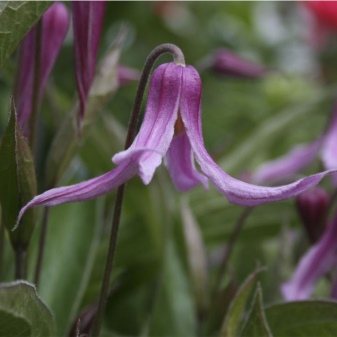

These bushes are used most often to create arches, decorate walls or fences.
Distinctive features
The characteristic features of the plant include:
- the average length of the vine is from 2 to 3 m;
- large drooping bell-shaped buds;
- compound leaves of the opposite type, attached to elongated cuttings.
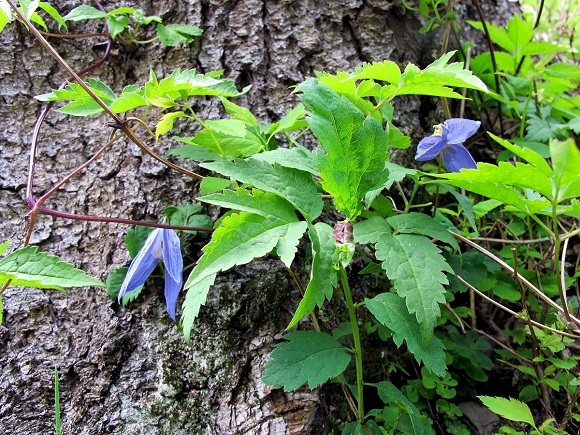

Variable phenotypic traits are:
- double or simple bud shape;
- bicolor, white, pink, blue, violet, lilac, purple petals;
- there are 4 to 8 sepals in the calyx.
In nature, 8 species of princelings have been registered, several of them grow on the territory of Russia. Of the imported varieties, Alpine clematis is especially popular. The prince's endurance, uncharacteristic for most clematis, has become the reason that many growers compare it to hops. The plant is popularly known under such common names as wild or upland hops. Outwardly, they are so similar that it is difficult to distinguish them in the photo. Previously, the prince was called atragen in the Latin manner.
Description of Knyazhik
The prince is a subgenus of the Lomonos genus from the Buttercup family. Currently, 8 species of the genus Knyazhika are known. The main place of distribution of this vine is the Northern Hemisphere.
The princes are a shrub vine with a stiff stem. With leaf stalks, the liana firmly clings to the support, beautifully braiding it.
Knyazhik's leaves are double pinnate, light green in color. Flowers - solitary, axillary, broadly bell-shaped with petal sepals. Each flower is approximately 10 cm in diameter.
The fluffy silver fruits of the Knyazhik are collected in the head.
clematis
A profusely flowering variety with a height of 2-3 m. Petals are wide, light pink-purple, dark pink at the base, outlined with a white edging. Internal stamens are greenish-white. The flowers are very large - up to 10 cm long. Price 350 rubles
One of the most beautiful old varieties of princes, bred in Sweden in 1982. Like all white and light princes, it grows only in the sun. The flowers are double, large, up to 7 cm in diameter. The outer and inner petals are equal in size in white, which makes the flower look ...
The name of the variety "ballet skirt" fully corresponds to the type of flower. Semi-double lush pale pink flowers - very large for this group, resemble a ballerina's pack. The height of the shoots is 2-2.5 m, they can not be lowered from the supports for the winter. Price 450 rubles
The variety was bred in Sweden in 1980 (Magnus Johnson). We were looking for a real Betina variety for a very long time. Somehow, many have other varieties under this name that have a completely different shape and color. The flowers of real Betina have a unique maroon-red color, half-open, ...
THIS VARIETY WILL NOT BE IN 2019 This variety was bred in Canada (F. L. Skinner) in 1962. It was not for nothing that this variety was called the “blue bird”. The petals of the flower are large, 5-7 cm, narrow and slightly wavy, resembling the wings of a swallow. An early flowering variety with large, beautiful, semi-double ...
A very unusual and unusually beautiful variety. In spring, large leaves are painted in burgundy tones. The buds are dark purple-burgundy. The flower is large, saturated blue-violet color with a bright clear white border. It blooms for a very long time from mid-May to late June, which is not typical for ...
This is a hybrid of Korean and Fori princes. The flowers are dark purple-violet with a brown tint and a matte, velvety coating. The flowers are large, simple, about 9 cm in diameter, with very thick and dense petals with embossed veins. The leaves are large, green, thick - this is a quality that ...
This variety will be the best decoration for your garden. Bred in Canada (F. L.Skinner) in 1961. The name of the variety is translated as “white swan”. It is considered one of the most beautiful white terry princes, 2-3 m high. The flowers are large (5-7 cm), neat, airy. Blossoms ...
The height of the vine is 3-4 m. An early and long-flowering variety with bright purple-blue large, velvety flowers. The flowers are large, half-open, the petals are wide and look heavy, as if the flower is densely double. An elegant variety, grows easily, tolerates a discharged sun. Foliage…
Bred in Holland (Piter Zwijnenburg). A variety with very attractive double flowers of an unusual color: outer petals are bright pink, inner ones are yellow with pink veins. The flowers are large, up to 8 cm. It blooms in May-June, again in August-September. Price 300 rubles
FOR 2019 THIS VARIETY WILL NOT BE An interesting variety of prince, with bright purple large flowers bordered with a clear white border. Liana up to 4 m high, powerful. Blooms profusely, even in a light shade, the bloom is amazing. Re-bloom in August. Price rubles
FOR 2019 THIS VARIETY WILL NOT BE Bred in England (Kathleen Goodman) in 1986. The variety is named after the English actress Constance Cummings. Double purple-red flowers 5-7 cm in diameter. Low-growing liana 2 m tall, with strong lashes and dense bright foliage. Not demanding ...
Bred in England (G. Jackman & Son) in 1958. Flowers are intensely blue, lighter inside, double with raised petals, very large, about 7 cm in diameter. Abundant flowering in May-June. The height of the vine is 2.5-3 m. The price is 300 rubles
IN 2019 THIS VARIETY WILL NOT BE This unusual variety was obtained in Canada in 1992 from seeds collected in Korea. The flowers are bell-shaped, very memorable - they consist of 4 fleshy, shiny petals with raised raised ribs on the upper side, bright yellow, purple at the base. Blooms profusely ...
The height of the liana is 2-3 m, the flowers are large up to 10 cm, with a slight scent of citrus, soft cream color, when blooming they become almost white and slightly open. The variety grows very well and blooms profusely. The price of one seedling is 350 rubles
The newest variety was bred in Poland (Szczepan Marczynski) in 2004, on sale since 2012. The height of the vine is up to 3 m, very resistant to diseases. The flowers are large (especially for princes) up to 12 cm in diameter, drooping with a delicate aroma of grapefruit, densely double, light lemon in color. Buds ...
Bred in England (Ernest Markham) in 1935. Early flowering variety 2-3 m high. Semi-double bright pink flowers, 5-8 cm long. It blooms profusely, grows quickly, easily tolerates partial shade. Price 300 rubles
The length of the shoots is 3-4 m. The flowers are beautiful, light blue, semi-double. Abundant flowering on last year's shoots in May-June, individual flowers appear throughout the summer. Price 300 rubles
A special variety due to its very large flowers up to 10 cm in diameter. They are semi-double, wide-open, and consist of a large number of narrow purple-violet-pink petals. The stamens in the center of the flower are lemon yellow. The flowering is very abundant. The height of the vine is 2.5-3 m. The price is 500 ...
One of the most abundant varieties of princes. The height of the vine is 3-4 m. The flowers are very large, 7-8 cm, bright blue, do not fade in the sun. It blooms for a long time from mid-May to mid-June, again in August. The price of one seedling is 300 rubles
Polish variety, new, on sale since summer 2013. Terry flowers, very large for princes - bell-shaped with a diameter of 10-12 cm, slightly smelling of grapefruit, on purple peduncles. The flower has 4 outer large, intricately twisted sepals, rich pink outside and ...
Received this variety in Sweden (Magnus Johnson) in 1972, by pollination of Siberian and Korean princes. The variety turned out to be strong, with a very strong and healthy vigor of growth and development. The flowers are large, 5-8 cm in diameter, double, red-violet, with a slight odor. The inner petals are the same color and ...
The newest beautiful variety was bred in Poland (Szczepan Marczynski) in 2004, on sale since 2012. The height of the vine is 2.5-3 m. The flowers are densely double, drooping, on purple stalks, with a delicate citrus aroma. The outer petals are wide creamy pink, the inner narrower petals are the same ...
(Miss E. Jones) in 1993. One of the longest flowering varieties. Plant height 2-3 meters. The flowers are bell-shaped, drooping, double, light pink, darker at the base. Flower diameter 5-7 cm. Price 300 rubles
v-v-v7.
Let's summarize


- The princes are a relative of clematis.Plants differ only in the structure of the flower.
- There are four decorative types of princes. The most popular varieties sold in most stores are Francis Reeves, Stolvik Gold, Pink Flamingo, Pamela Jackman (alpine species), as well as Maidway Hall, Cecile, Markhvens Pink (large-petal species).
- You can plant the plant in a secluded, shaded corner of the garden.
- When growing clematis, remember: they love moisture, so they need to be watered from time to time, and between waterings, a layer of mulch should be renewed on the site.
Alpine prince
The lianas of the Alpine prince, as well as the Siberian, grow up to 3 m in length. The sepals of this prince are blue-violet. Their diameter can be from two to six centimeters, there are 4 sepals in total. Flowering occurs from May to late June.
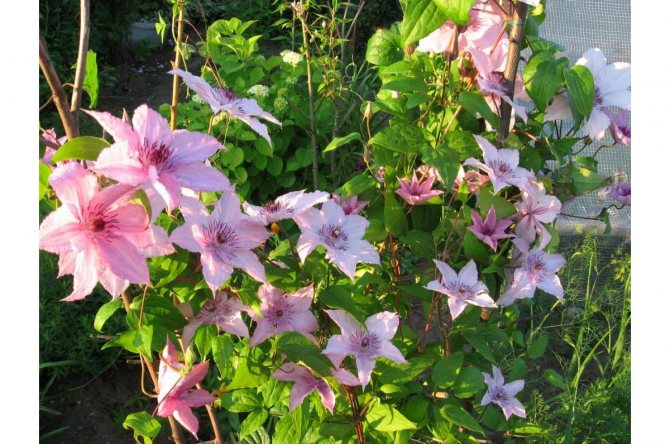

Initially, the Alpine prince grew only in Central and Southern Europe.
If the first flowers appear on the shoots of the warm season of the previous year, then re-flowering can be seen in August or September, while on the shoots of this year. To renew and rejuvenate a shrub, it is enough to cut it just two buds from the very base.
The Alpine prince became a kind of ancestor of all other varieties of princes.


